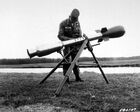
Nukes in Space-The Rainbow Bombs
Nukes in Space-The Rainbow Bombs.
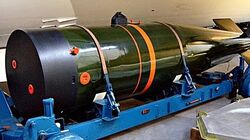
Worlds Top 5 Nuclear Power Comparison 2015.
Worlds Top 5 Nuclear Power Comparison 2015.
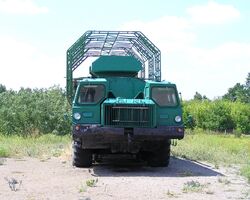
A Soviet SS-20 nuke and launcher truck.
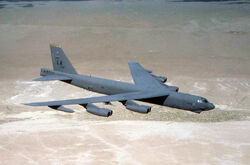
A B-52 bomber.
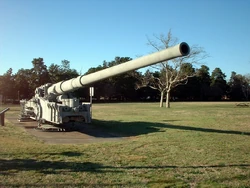
The Anomic Annie nuclear artillery peace.
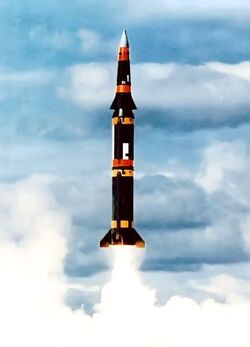
The US launching a Pershing II missile.

HOW IT WORKS The Atomic Bomb (720p)-0
HOW IT WORKS: The Atomic Bomb (720p). FOLLOW ON: https://www.facebook.com/documentarytube.net https://twitter.com/DocArchive
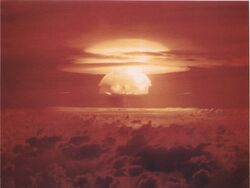
The American's Castle Bravo test blast.
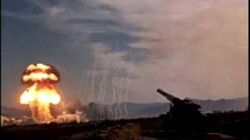
The Atomic Cannon (Upshot-Knothole Grable) 15 kt
The America atomic cannon test (Upshot-Knothole Grable), in which it was firing a 15 kt atomic shell.

The nuke hit these places in 1981: Peterborough (strategic transport links and a major city) 100kt, RAF Upwood 1x 10Kt, RAF Alconbury 1x 10Kt, RAF Molesworth 1x 10Kt, RAF Waterbeach 1x 10kt, Bassingbourn Barracks 1x 10Kt, Cambridge (government outpost, strategic transport links and a major city) 2x 100kt or 1x 200kt. Don't beleive the claims of the American, Russian or British political establishment, atomic war is not fun-it's a hellhole that even frightens the PRC!

The nuke hit these places in 1981: Kursk (strategic transport links and regional government centre)- 1x 335kt or 350kt, or 2x 150kt, Khalino airbase/Kursk Vostochny Airport- 1x 5kt.
Overview
The term "Holocaust" and "Nuclear".
The English word "holocaust", derived from the Greek language's term "holokaustos" meaning "completely burnt", is commonly defined as "a great destruction resulting in the extensive loss of life, especially by fire."
The English word "nuclear\nukes", derived from the Latin language's term "nucleus" meaning "kernel", from nucula, little nut, diminutive of nux, nuc-, "nut". In this case it is relating to weapons, or the use of weapons, which use the power produced when the nucleus of an atom is divided or joined to another nucleus (nuclear weapon\nuke).
It literally means "incinerated\cremated nuts" in Latin and Greek!
The term "TNT equivalent"

The Terrifying True Scale of Nuclear Weapons-0
Nuclear weapons have come a long way and come in all types of different sizes. Some are relatively small while others are enormous, so big they boggle the mind at what they can be capable of. This video analyzes the sizes and impacts of various different nuclear devices, the history of nuclear weapons and what countries in the world are in possession of such devices. Music used is by Ross Bugden, check out his channel here! https://www.youtube.com/channel/UCQKGLOK2FqmVgVwYferltKQ?spfreload=5 The exact song is titled; Something wicked, and can be found here https://www.youtube.com/watch?v=Zuw_O5MU5CE&spfreload=5 Data gathered from Nukemap, check them out! Google Earth Pro used for several imaging shots, used under fair use. Video Credits: Hiroshima bombing and crossroads nuclear weapons test: https://archive.org/details/AFP-67AG_NET356_R-6 used here under fair use. PLEASE SUBSCRIBE: Facebook: https://www.facebook.com/RealLifeLore/ Follow us on Twitter: https://twitter.com/RealLifeLore1 Videos explaining things. Mostly over topics like history, geography, economics and science. We believe that the world is a wonderfully fascinating place, and you can find wonder anywhere you look. That is what our videos attempt to convey.
TNT equivalent is a convention for expressing energy, typically used to describe the energy released in an explosion. The term "a ton of TNT" is a unit of energy defined by that convention to be 4.184 gigajoules, which is the approximate energy released in the detonation of a metric ton (1,000 kilograms or one megagram) of TNT. The convention intends to compare the destructiveness of an event with that of conventional explosives, of which TNT is a typical example (although other conventional explosives such as dynamite contain more energy).
The "kiloton (of TNT)" is a unit of energy equal to 4.184 terajoules.
The "megaton (of TNT)" is a unit of energy equal to 4.184 petajoules.
The kiloton and megaton of TNT have traditionally been used to describe the energy output, and hence the destructive power, of a nuclear weapon. The TNT equivalent appears in various nuclear weapon control treaties, and has been used to characterize the energy released in such other highly destructive events as an asteroid impact.
The explosive yield of a nuclear weapon is the amount of energy released when that particular nuclear weapon is detonated, usually expressed as a TNT equivalent (the standardized equivalent mass of trinitrotoluene which, if detonated, would produce the same energy discharge), either in kilotons (kt—thousands of tons of TNT), in megatons (Mt—millions of tons of TNT), or sometimes in terajoules (TJ). An explosive yield of one terajoule is 0.239 kt of TNT. Because the accuracy of any measurement of the energy released by TNT has always been problematic, the conventional definition accepted since the dawn of the Atomic Age is that one kiloton of TNT is simply to be 1012 calories equivalent, which is only approximately equal to the energy yield of 1,000 tons of TNT.
The yield-to-weight ratio is the amount of weapon yield compared to the mass of the weapon. The practical maximum yield-to-weight ratio for fusion weapons (thermonuclear weapons) has been estimated to six megatons of TNT per metric ton of bomb mass (25 TJ/kg). Yields of 5.2 megatons/ton and higher have been reported for large weapons constructed for single-warhead use in the early 1960s. Since this time, the smaller warheads needed to achieve the increased net damage efficiency (bomb damage/bomb weight) of multiple warhead systems, has resulted in decreases in the yield/weight ratio for single modern warheads.
The relative effectiveness factor, or R.E. factor, relates an explosive's demolition power to that of TNT, in units of the TNT equivalent/kg (TNTe/kg). The R.E. factor is the relative mass of TNT to which an explosive is equivalent; the greater the R.E., the more powerful the explosive.
This enables engineers to determine the proper masses of different explosives when applying blasting formulas developed specifically for TNT. For example, if a timber-cutting formula calls for a charge of 1 kg of TNT, then based on octanitrocubane's R.E. factor of 2.38, it would take only 1.0/2.38 (or 0.42) kg of it to do the same job. Using PETN, engineers would need 1.0/1.66 (or 0.60) kg to obtain the same effects as 1 kg of TNT. With ANFO or ammonium nitrate, they would require 1.0/0.74 (or 1.35) kg or 1.0/0.42 (or 2.38) kg, respectively.
Nukes were to be measured in the much greater megaton and kiloton range due to their massive blasts.
- Example: Mk-54 (Davy Crockett) – 10 or 20 tons (AKA: 0.010 kilotons or 0.020 kilotons) yield, Davy Crockett artillery warhead.
- Example: Mk-54 (SADM) – approximate yield from 10 tons to 1 kiloton, Special Atomic Demolition Munition device.
- Example: W48 was an American nuclear artillery shell – 72 tons of TNT (0.072 kiloton).
- Example: Pluton missile– 15 or 25 kilotons.
- Example: Little Boy bomb– ~16 kilotons.
- Example: Operation Buster test blast– 21 kilotons.
- Example: 3x W58 warhead in the UGM-27 Polaris– 200 kilotons for each one.
- Example: R-12 (SS-4 Sandal)- 2.3 megatons
- Example: Ivy Mike test blast – 10.4 megatons.
Atomic\nuclear war
"Nukes" or nuclear weapons are the name given to all radiological, fusion and fission weapons. War with these weapons is called atomic war and could lead to a nuclear\atomic holocaust or nuclear apocalypse. A nuclear weapon is an explosive device that derives its destructive force from nuclear reactions, either fission (fission bomb) or a combination of fission and fusion (thermonuclear weapon) like the ones used in the atomic bombings of Hiroshima and Nagasaki in 1945. The first fission ("atomic") bomb test released the same amount of energy as approximately 20,000 tons of TNT (see Trinity (nuclear test)). The first thermonuclear ("hydrogen") bomb test released the same amount of energy as approximately 10,000,000 tons of TNT.
Technically speaking, Atomic war would be any war in which nuclear weapons are used, ranging from a single, small weapon (like a bunker buster or the ones dropped by the United States on Japan in World War II) or a ad-hock terrorist bomb and all the way up to a full-blown assault between nuclear powers using atomic arms and their opponents (including those without nukes).
Who can launch them
They are launched by the use of the military's nuclear launch codes and the authority and authentication of the leader's, deputy leader's and/or defense minister's Nuclear briefcase (UK) Cheget (USSR), «mobile base» (France) or Nuclear football (USA).
Wartime usage
It would be used in World War 3 if mass death and destruction was needed and may then lead to A nuclear\atomic holocaust or nuclear apocalypse|a nuclear\atomic holocaust or nuclear apocalypse. The first fission ("atomic") bomb test released the same amount of energy as approximately 20,000 tons of TNT at the Trinity nuclear test. The first thermonuclear ("hydrogen") bomb test released the same amount of energy as approximately 10,000,000 tons of TNT. The Hiroshima bomb was War with these weapons is called atomic war and could lead to a nuclear\atomic holocaust or nuclear apocalypse. The Hiroshima bomb released the same amount of energy as approximately 20,000 tons of TNT and the Davy Crockett Weapon System released the same amount of energy as approximately 20 tons of TNT and the MGM-52 Lance missile could release 1,000 to 100,000 tonnes of TNT equivalent of explosive energy.
The resulting phenomena
A nuclear holocaust or nuclear apocalypse would be a possible complete or nearly complete annihilation of human life through the use of nuclear weapons. Under such a scenario, all or most of the Earth is made uninhabitable by nuclear warfare in future world wars after a mass exstange of nukes in the war!
The energy equation
- Blast and the resulting air shockwave—40–50% of total energy.
- Thermal (heat) radiation —30–50% of total energy.
- Ionizing (Gamma rays, X-rays, and the higher ultraviolet) radiation—5% of total energy (more in a neutron bomb).
- Residual (Alpha and Beta radiation) radiation—5–10% of total energy with the mass of the explosion.
- ~1% Light, EMP, microwaves and radio waves.
Defining the weapons them selves and how to use them

HD British Hydrogen bomb explosion test awesome-0
HD British Hydrogen bomb explosion test awesome!

Hiroshima Atomic Bomb Video
Hiroshima Atomic Bomb that killed so many!

Rare footage of Nagasaki atomic bombing
Rare footage of Nagasaki atomic bombing that killed so many!

India 's 1st Nuclear Test
Smiling Buddha India 's First Nuclear Test.

UNDERWATER NUKE!-0
This footage is from operation Hardtack and this explosion is from an 8-kiloton nuclear bomb named Umbrella. Here's a link to a picture where you can see all of the water splash:?
The difference between the different types of nuclear weapons (nukes)
- Atomic bomb\Atom bomb\A-bombs- An A-bomb is any form of nuclear weapon is an explosive device that derives its destructive force from nuclear reactions, either fission (fission bomb) or a combination of fission and fusion (thermonuclear weapon) like the ones used in the atomic bombings of Hiroshima and Nagasaki in 1945. The first fission ("atomic") bomb test released the same amount of energy as approximately 20,000 tons of TNT (see Trinity (nuclear test)). The first thermonuclear ("hydrogen") bomb test released the same amount of energy as approximately 10,000,000 tons of TNT. Technically, a H-bomb is a form of A-bomb, but has got it's own name due to it's different chemistry and much larger yield pattern.
- Cobalt bomb\Co-bombs- A cobalt bomb is a theoretical type of "salted bomb": a nuclear weapon designed to produce enhanced amounts of radioactive fallout, intended to contaminate a large area with radioactive material. The concept of a cobalt bomb was originally described in a radio program by physicist Leó Szilárd on February 26, 1950. His intent was not to propose that such a weapon be built, but to show that nuclear weapon technology would soon reach the point where it could end human life on Earth, a doomsday device. Such "salted" weapons were requested by the U.S. Air Force and seriously investigated, but not deployed. In the 1964 edition of the DOD/AEC book The Effects of Nuclear Weapons, a new section titled radiological warfare clarified the "Doomsday device" issue. Samuel Glasstone, The Effects of Nuclear Weapons, 1962, Revised 1964, U.S. Dept of Defense and U.S. Dept of Energy, pp.464–5. This section was removed from later editions, but, according to Glasstone in 1978, not because it was inaccurate or because the weapons had changed.
- Meson bomb\M-bomb- The meson bomb was a proposed nuclear weapon, whose function was based on the energy of mesons. The idea behind the bomb was rejected by most scientists, but during Cold War, American intelligence managed to trick Soviet Union into conducting research on this topic, which resulted in several years of wasted labor by one of the Soviet nuclear weapon research bureaus.
- Radiological device\R-bomb\RRD\Radiological dispersion device\dirty bomb\D-bomb- A dirty bomb or radiological dispersal device is a theoretical radiological weapon that combines radioactive material with conventional explosives. A conventional explosive tied to some atomic waste, atomic fuel, a hospital radio-therapy unit, barrel of 'heavy water', a deactivated atomic warhead or a similar sort of thing. The blast scatters the radioactive part around a large location and in to the air with out a fissile atomic blast.
- Enhanced Radiation Weapon\ERW\Neutron bomb\N-bombs- A neutron bomb, officially termed one type of Enhanced Radiation Weapon (ERW), is a low yield thermonuclear weapon in which a burst of neutrons generated by a nuclear fusion reaction is intentionally allowed to escape the weapon, rather than being absorbed by its other components. The neutron bomb was to be used as a tactical nuclear weapon intended for use against armored forces. Originally conceived by the U.S. military, their design goals were to stop massed Soviet armored divisions from overrunning allied nations without destroying the infrastructure of the allied nation. The weapon's radiation case, usually made from relatively thick uranium, lead or steel in a standard bomb, is, instead, made of as thin a material as possible, to facilitate the greatest escape of fusion-produced neutrons. The usual nuclear weapon yield—expressed as kilotons of TNT equivalent—is not a measure of a neutron weapon's destructive power. It refers only to the energy released (mostly heat and blast), and does not express the lethal. It would make many building materials in the city radioactive, such as zinc coated steel/galvanized steel for area denial purposes. :The pulse of neutron radiation from a 1kt bomb would cause immediate and permanent incapacitation to unprotected outdoor humans in the open out to 900 meters, with death occurring in one or two days. The median lethal dose (LD50) of 600 rads would extend to about 1350–1400 meters for those unprotected and outdoors, where approximately half of those exposed would die of radiation sickness after several weeks. However a human residing within, or simply shielded by, at least one of the aforementioned concrete buildings with walls and ceilings 30 cm (12 in) thick, or alternatively of damp soil 24 inches thick, would receive a neutron radiation exposure reduced by a factor of 10. Even near ground zero, basement sheltering or buildings with similar radiation shielding characteristics, would drastically reduce the radiation dose. Furthermore, the neutron absorption spectrum of air is disputed by some authorities and depends in part on absorption by hydrogen from water vapor. Thus, it might vary exponentially with humidity, making neutron bombs far more deadly in desert climates than in humid ones. Considerable controversy arose in the U.S. and Western Europe following a June 1977 Washington Post exposé describing U.S. government plans to purchase the bomb. The article focused on the fact that it was the first weapon specifically intended to kill humans with radiation. Lawrence Livermore National Laboratory director Harold Brown nd Soviet General Secretary Leonid Brezhnev both described the neutron bomb as a "capitalist bomb", because it was designed to destroy people while preserving property. Science fiction author Isaac Asimov also stated that "Such a neutron bomb or N-bomb seems desirable to those who worry about property and hold life cheap. By 1984, according to Mordechai Vanunu, Israel was mass-producing neutron bombs. America, France and the USSR had also deployed them at times.
- Thermonuclear\T-bomb\Hydrogen bomb\H-bombs- A hydrogen bomb or H-bomb, weapon deriving a large portion of its energy from the nuclear fusion of hydrogen isotopes. In an atomic bomb, uranium or plutonium is split into lighter elements that together weigh less than the original atoms, the remainder of the mass appearing as energy. Unlike this fission bomb, the hydrogen bomb functions by the fusion, or joining together, of lighter elements into heavier elements. The end product again weighs less than its components, the difference once more appearing as energy. Because extremely high temperatures are required in order to initiate fusion reactions, the hydrogen bomb is also known as a thermonuclear bomb. A thermonuclear weapon is a nuclear weapon that uses the energy from a primary nuclear fission reaction to compress and ignite a secondary nuclear fusion reaction. The result is greatly increased explosive power when compared to single-stage fission weapons. It is colloquially referred to as a hydrogen bomb or H-bomb because it employs fusion of isotopes of hydrogen. The fission stage in such weapons is required to cause the fusion that occurs in thermonuclear weapons. The misleading term "hydrogen bomb" was already in wide public use before fission product fallout from the Castle Bravo test in 1954 revealed the extent to which the design relies on fission.
- Helium bomb\He-bomb- The Helium bomb was proposed variant of the H-bomb. Hydrogen fusion is much more efficient than helium fusion, and thus is more desirable for a bomb. Helium-3 would theoretically make better a fusion bomb. 1 ton of helium-3 has the potential to produce 1.5 times more destructive power than the Tsar Bomba. Tsar Bomba had 50 megatons (50Mt) of yield. Considering it already takes an atomic-fission bomb to create the necessary conditions for large-scale hydrogen fusion, it would need something even more powerful to create the conditions for helium fusion. Technically, a H-bomb is a form of A-bomb, but has got it's own name due to it's different chemistry and much larger yield pattern.
- Antimatter bomb\An-bomb\Anti-m-bomb\Anti-bomb- An antimatter weapon is a hypothetical device using antimatter as a power source, a propellant, or an explosive for a weapon. Antimatter weapons are not thought to currently exist due to the cost of production and the limited technology available to produce and contain antimatter in sufficient quantities for it to be a useful weapon. The United States Air Force, however, has been interested in military uses – including destructive applications – of antimatter since the Cold War, when it began funding antimatter-related physics research. Using the convention that 1 kiloton TNT equivalent = 4.184e^12 joules, the gram of antimatter reacting with its ordinary matter counterpart gives 43 kilotons of explosive force. It is very dangerous to store and use since an antimatter weapon would have to be actively kept from exploding; a nuclear weapon will not explode unless active measures are taken to make it do so. A major obstacle is the cost of producing antimatter even in small quantities. As of 2004, the cost of producing one millionth of a gram of antimatter was estimated at US$60 billion. By way of comparison the cost of the Manhattan project to produce the first atomic weapon was estimated at US$23 billion at 2007 prices. Smaller one off assassination weapons are more economically feasible: A modern MK3 hand grenade contains 227g of TNT. One billionth of a gram of positrons contains as much energy as 37.8 kilograms (83 pounds) of TNT, making the 2004 cost of a 'positron hand grenade' (10 trillionth of a gram of antimatter, 378g TNT equivalent) that could be fitted in a sniper's bullet US$600,000. This excludes the cost of the micro containment device, if such a thing is possible.
- Electron bomb\EM-bomb\EMP-bomb\EMP-device\E-bomb- The damaging effects of EMP have led to the introduction of EMP weapons, from tactical missiles with a small radius of effect to nuclear bombs. It creates a burst of energy that fries electronic circuits within a blast radius, an EMP could theoretically knock out a power grid if it were large enough. The U.S. Air Force and Boeing made a prototype electromagnetic pulse weapon, capable of targeting and destroying electrical systems without the collateral damage often associated with ordenery ordinance. The U.S. could have a new high-tech electromagnetic weapon in its arsenal, and terrorists might be building their own low-tech type of EMP bomb.
- S-bomb\Salted bombs- A salted bomb should not be confused with a dirty bomb, which is an ordinary chemical explosive bomb containing radioactive material which is spread over the area when the bomb explodes. A salted bomb is able by desinge to contaminate a much larger area than a dirty bomb.
The difference between the different types of detonation location
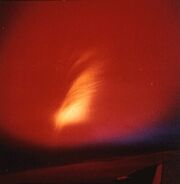
The debris fireball and aurora created by the Starfish Prime test, as seen from a KC-135 aircraft at 3 minutes on July 9, 1962. Yield 1,450 kilotons.
- Surface\land\landbourne\conventional discharge burst- on the land.
- Air\sky burst\above surface\in the air\airborne- in the air.
- High altitude exploitation\space-blast\space-nuke\sky-nuke\rainbow bomb- in the upper atmosphere or outer space.
- Terrorist weapon\nuke\atomic device detonation\incident- by a terrorist cell or criminal gang.
- Sea/marine/nortical/ocean burst/below water/sub-marine/seabourne- in or on the sea or any other major body of water.
- Subterranean\sub-surface\beneath-surface\beneath the ground\mineshaft\mine-works\underground\buried burst- beneath the ground.
- Fault-line blast\fault-line detonation- on or in a systemic fault-line.
The difference between delivery systems
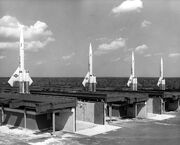
CIM-10 Bomarc missile anti-aircraft nukes.
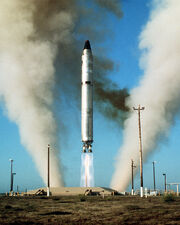
A Titan II missile launch from Vandenberg Air Force Base.
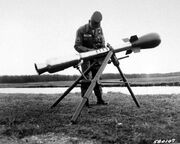
Photograph of a U.S. developed M-388 Davy Crockett nuclear weapon mounted to a recoilless rifle on a tripod, shown here (1961) at the Aberdeen Proving Ground in Maryland in March 1961. It used the smallest nuclear warhead ever developed by the United States.
- A bomb- A bomb.
- Dumb\unguided bomb- A Dumb\unguided bomb.
- Smart bomb- A Smart bomb.
- Terrorist device\bomb- A (possibly just ad-hock) terrorist device\bomb
- Warhead- A SAM, ICBM, MRBM, cruse missile or torpedo's warhead.
- Artillery shell- An artillery shell.
- Mine- A land or sea mine.
- Torpedo- A torpedo.
- SAM (anti-aircraft) missile- A SAM missile.
- ICBM missile- An intercontinental ballistic missile (ICBM) is a guided ballistic missile with a minimum range of 5,500 kilometers (3,400 mi) primarily designed for nuclear weapons delivery (delivering one or more thermonuclear warheads). Similarly conventional, chemical and biological weapons can also be delivered with varying effectiveness, but have never been deployed on ICBMs. Most modern designs support multiple independently targetable reentry vehicles (MIRVs), allowing a single missile to carry several warheads, each of which can strike a different target.
- MRBM\IRBM missile- An intermediate-range ballistic missile (IRBM) is a ballistic missile with a range of 3,000–5,500 km (1,864–3,418 miles), between a medium-range ballistic missile (MRBM) and an intercontinental ballistic missile (ICBM). Classifying ballistic missiles by range is done mostly for convenience, in principle there is very little difference between a low-performance ICBM and a high-performance IRBM. The range definition used here is used within the U.S. Missile Defense Agency. Some other sources include an additional category, the long-range ballistic missile (LRBM), to describe missiles with a range between IRBMs and true ICBMs. The more modern term theater ballistic missile encompasses IRBMs, MRBMs and SRBMs, including any ballistic missile with a range under 3,500 km (2,175 mi).
- Cruse missile- A cruse missile.
- Balistic missile- A ballistic missile.
- Recoiless rifle round- a recoiless rifle round.
- Mortar shell- A mortar shell.
- Bazooka or RPG round- A RPG round.
Physical size
There is a popular myth they have to be big. This is not true, beyond the first few years, due to the advance of technology. Yield and weight are also major factors in the size of the weapon.
Immediate non-atomic results


Baneberry's accidental radioactive plume rises from a shock fissure and into wind on December 18, 1970,
The United States, with the consent of the United Kingdom as laid down in the Quebec Agreement, dropped nuclear weapons on the Japanese cities of Hiroshima and Nagasaki in August 1945, during the final stage of World War II.
This general effects can be gauged by the nukeings of Hiroshima and Nagasaki, along with test blasts like one with the vehicles and wooden bindings at the Nevada Test Site, when Atomic Annie fired 16kt shot at them as part of of Operation Upshot-Knothole.
Places like Bikini Atoll and events like the 1960 Bomarc Missile accident can be used as a way of assessing the ground zero and storage site contamination respectively, over the long turn. Disasters like the Chernobyl disaster and Three Mile Island accident also act as a second fallout guide.
Acute radiation syndrome (ARS), also known as radiation poisoning, radiation sickness or radiation toxicity, is a collection of health effects which present within 24 hours of exposure to high amounts of ionizing radiation. Server burns, material damage and electrical damage due to the EMP would also occur in an atomic war.
Death and destruction par-sea
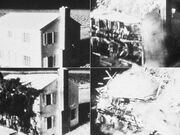
Wood frame house in 1953 nuclear test, 5 pounds per square inch (psi) overpressure, full collapse. Although neutron bombs, such as that fitted on the MGM-52 Lance missile would cause similar levels of destruction as depicted here within the zone were ~1970s tank crews would also be incapacitation by neutron radiation. When compared to the range of destruction that would be caused by the comparatively higher yield conventional nuclear weapons that it supplanted (e.g., MGR-1 Honest John), which had been needed to deliver the same range and intensity of neutron dose to neutralize tank crews, the range of civilian destruction and amount of fission product fallout generated by a neutron bomb is far more constrained. Sparing the destruction of West Germany more than would otherwise be the case. It was done at the Nevada Test Site, when Atomic Annie fired 16kt shot at them as part of of Operation Upshot-Knothole.
As the destroyed house's image shows, the obvious material loss wound be heavy. In addition to this people, animals and plants would die. Key national\regional\local figures, vital facilities, transport hubs and supply depots would be destroyed; causing even more chaos! Refugees, wounded and the dead present there own hazards to.
- A 10kt surface blast would cause-
- Fireball radius: 200 m (0.12 km²)
- Air blast radius (20 psi): 470 m (0.69 km²)
- Air blast radius (5 psi): 0.99 km (3.06 km²)
- Radiation radius (500 rem): 1.25 km (4.91 km²)
- Thermal radiation radius (for 3rd degree burns): 1.41 km (6.22 km²) 100% probability for 3rd degree burns a 10kt yield is 8.4 cal/cm2.
The over-pressure event
Explosive shock waves can cause situations such as body displacement (i.e., people being thrown through the air), dismemberment, internal bleeding and ruptured eardrums.
Shock waves produced by explosive events have two distinct components, the positive and negative wave. The positive wave shoves outward from the point of detonation, followed by the trailing vacuum space "sucking back" towards the point of origin as the shock bubble collapses. The greatest defense against shock injuries is distance from the source of shock.
As a point of reference, the over-pressure at the Oklahoma City bombing was estimated in the range of 28 MPa.
Primary injuries are caused by blast over-pressure waves, or shock waves. These are especially likely when a person is close to an exploding munition, such as a land mine. The ears are most often affected by the over-pressure, followed by the lungs and the hollow organs of the gastrointestinal tract. Gastrointestinal injuries may present after a delay of hours or even days. Injury from blast over-pressure is a pressure and time dependent function. By increasing the pressure or its duration, the severity of injury will also increase.
Blast effects are usually measured by the amount of over-pressure, the pressure in excess of the normal atmospheric value, in pounds per square inch (psi). There is a 1 to 50 psi (6.9 to 345 kilopascals) over-pressure event when a 1 kiloton of TNT equivalent nuke is air burst.
- A 10kt standard altitude air blast would cause-
- 15 psi: 0.33 miles
- 10 psi: 0.41 miles
- 7 psi: 0.5 miles
- 5 psi: 0.61 miles
- 2 psi: 1.06 miles
- 1 psi: 1.56 miles
- 0.25 psi: 4.01 miles
- 0.1 psi: 8.21 miles
- 0.25 psi, Most glass surfaces, such as windows, will shatter within this ring, some with enough force to cause injury.
- 1 psi, 38 mph shock-wave wind, Window glass shatters. Light injuries from dislodged fragments and the debris occur.
- 2 psi, 70 mph shock-wave wind, Moderate damage to houses with the windows and doors blown out and severe damage to roofs being commonplace. People injured by shrapnel made of flying glass and debris.
- 3 psi, 102 mph shock- wave wind, Residential structures collapse. Serious injuries are common, fatalities may occur.
- 5 psi, 163 mph shock-wave wind, Most non-reinforced buildings collapse. Trees are torn up and cars are flung about. Injuries are universal and fatalities are widespread. It ruptures the eardrums in about 1% of people in the zone.
- 7 psi Severe damage to complete destruction of reinforced concrete structures, such as skyscrapers, will occur within this ring.
- 10 psi, 294 mph shock-wave wind, Reinforced concrete buildings are severely damaged or demolished. Most people are killed.
- 20 psi, 502 mph shock-wave wind, Most heavily built reinforced concrete buildings and some bunkers are severely damaged or demolished. Fatalities approach 100%. Barotrauma to people and animals is commonplace.
- 45 psi, Most bunkers and all heavily biult reinforced buildings will collapse. The over-pressure will cause eardrum rupture in about 99% of all victims in the zone.
- 50 psi, Only the most heavy and sturdy of 'doomsday bunkers' will survive, but they are badly damaged! The death toll is now 100%, with the handful who may survive the blast are horrifically, if not fatally injured!
- 55 psi, Nothing remains intact and all life forms died instantly! Every thing is torn apart!
In general, primary blast injuries are characterized by the absence of external injuries; thus internal injuries are frequently unrecognized and their severity underestimated. According to the latest experimental results, the extent and types of primary blast-induced injuries depend not only on the peak of the over-pressure, but also other parameters such as number of over-pressure peaks, time-lag between over-pressure peaks, characteristics of the shear fronts between over-pressure peaks, frequency resonance, and electromagnetic pulse, among others.
There is general agreement that spalling, implosion, inertia, and pressure differentials are the main mechanisms involved in the pathogenesis of primary blast injuries. Thus, the majority of prior research focused on the mechanisms of blast injuries within gas-containing organs and organ systems such as the lungs, while primary blast-induced traumatic brain injury has remained underestimated. Blast lung refers to severe pulmonary contusion, bleeding or edema type swelling with damage to alveoli and blood vessels, or a combination of these. It is the most common cause of death among people who initially survive an explosion.
Displacement of air by the explosion creates a blast wind that can throw victims against solid objects. Injuries resulting from this type of traumatic impact are referred to as tertiary blast injuries. Tertiary injuries may present as some combination of blunt and penetrating trauma, including bone fractures and coup contre-coup injuries in the victim's heads. Children are at a particularly higher risk of tertiary injury due to their relatively smaller body weight.
Burns
A burn is a type of injury to skin , or other tissues, caused by heat, electricity, chemicals, friction, or radiation. Burns that affect only the superficial skin layers are known as superficial or first-degree burns. When the injury extends into some of the underlying layers, it is described as a partial-thickness or second-degree burn. In a full-thickness or third-degree burn, the injury extends to all layers of the skin. A fourth-degree burn additionally involves injury to deeper tissues, such as muscle, tendons, or bone.
The treatment required depends on the severity of the burn. Superficial burns may be managed with little more than simple pain medication, while major burns may require prolonged treatment in specialized burn centres. Cooling with tap water may help relieve pain and decrease damage; however, prolonged exposure may result in low body temperature. Partial-thickness burns may require cleaning with soap and water, followed by dressings. It is not clear how to manage blisters, but it is probably reasonable to leave them intact. Full-thickness burns usually require surgical treatments, such as skin grafting. Extensive burns often require large amounts of intravenous fluid, because the subsequent inflammatory response causes significant capillary fluid leakage and edema. The most common complications of burns involve infection.
While large burns can be fatal, modern treatments developed since the early 1960s have significantly improved the outcomes, especially in children and young adults. Globally, as of 2015, about ~11 million people seek medical treatment, and 300,000 die from burns each year. In the United States, approximately 96% of those admitted to a burn centre survive their injuries. The long-term outcome is primarily related to the size of burn and the age of the person affected.
- Burn types.
- Thermal (Burns with a hot object, vapor, fire or open heat source)
- Scalds (Burns with a hot fluid)
- Chemical
- Flash
- Electrical
- Radiation
- Cold (Frostbite/freezer burn)
- Aerosol burn (An cold skin burn caused by a pressurized gas within an aerosol spray or cylinder cooling quickly enough to cause frostbite.).
There are 6 types of burn, of which thermal, flash and radiation burns will occur in an atomic war. Hot gasses, heat, cold, cold gases, radioactive particles and chemical fumes can be inhaled and burn lungs and throats. Radioactive particles and chemicals can be ingested and burn throughs and stomachs. The characteristics of a burn depend upon its depth. Superficial burns cause pain lasting two or three days, followed by peeling of the skin over the next few days. Individuals suffering from more severe burns may indicate discomfort or complain of feeling pressure rather than pain. Full-thickness burns may be entirely insensitive to light touch or puncture. While superficial burns are typically red in colour, severe burns may be pink, white or black. Burns around the mouth or singed hair inside the nose may indicate that burns to the airways have occurred, but these findings are not definitive. More worrisome signs include: shortness of breath, hoarseness, and stridor or wheezing. Pruritus itching is common during the healing process, occurring in up to 90% of adults and nearly all children. Numbness or tingling may persist for a prolonged period of time after an electrical injury. Burns may also produce emotional and psychological distress.
- Radiation-
Radiation burns may be caused by protracted exposure to ultraviolet light (such as from the sun, solarium tanning booths or arc welding) or from ionizing radiation (such as from radiation therapy, X-rays or radioactive fallout). Sun exposure is the most common cause of radiation burns and the most common cause of superficial burns overall. There is significant variation in how easily people sunburn based on their skin type. Skin effects from ionizing radiation depend on the amount of exposure to the area, with hair loss seen after 3Gy, redness seen after 10Gy, wet skin peeling after 20Gy, and necrosis after Redness, if it occurs, may not appear until some time after exposure. Radiation burns are treated the same as other burns. Microwave burns occur via thermal heating caused by the microwaves. While exposures as short as two seconds may cause injury, overall this is an uncommon occurrence.
- Thermal (heat)-
In the United States, fire and hot liquids are the most common causes of burns. Of house fires that result in death, smoking causes 25% and heating devices cause 22%. Almost half of injuries are due to efforts to fight a fire. Scalding is caused by hot liquids or gases and most commonly occurs from exposure to hot drinks, high temperature tap water in baths or showers, hot cooking oil, or steam. Scald injuries are most common in children under the age of five and, in the United States and Australia, this population makes up about two-thirds of all burns.
Contact with hot objects is the cause of about 20-30% of burns in children. Generally, scalds are either first or second degree burns, but third-degree burns may also result, especially with prolonged contact. Fireworks are a common cause of burns during holiday seasons in many countries. This is a particular risk for irresponsible adolescent males.
A thermal wave is created by the sudden release of heat caused by an explosion. Military bomb tests have documented temperatures of up to 2,480 °C (4,500 °F). While capable of inflicting severe to catastrophic burns and causing secondary fires, thermal wave effects are considered very limited in range compared to shock and fragmentation. This rule has been challenged, however, by military development of thermobaric weapons, which employ a combination of negative shock wave effects and extreme temperature to incinerate objects within the blast radius. This would be fatal to humans, as bomb tests have proven.
- 1st degree (superficial) burns. First-degree burns affect only the epidermis, or outer layer of skin.
- 2nd degree (partial thickness) burns. Second-degree burns involve the epidermis and part of the dermis layer of skin.
- 3rd degree (full thickness) burns. The injury extends to all layers of the skin.
- 4th Degree: Damage the underlying bones, muscles, and tendons.
- 5th Degree: Organs are burnt. A victim’s chance of survival close to zero and life afterwards is worthless
- 6th Degree: A 6th degree burns leave a charred skeleton.
- 7th Degree: Cremation ashes.
- Flash-
Flash burn is any burn injury caused by intense flashes of light, high voltage electric current, or strong thermal radiation. These may originate from, for example, a sufficiently large BLEVE, a thermobaric weapon explosion or a nuclear blast of sufficient magnitude. Damage to the eye(s) caused by ultraviolet rays is known as photokeratitis.
- Hopefully you won't catch fier using: burn-
osx.sourceforge.net "There are a lot of ways to approach burning discs. Burn keeps it simple, but still offers a lot of advanced options (Mac OS X)." acording to the site. http://burn-osx.sourceforge.net/Pages/English/home.html.
Shrapnel wounds
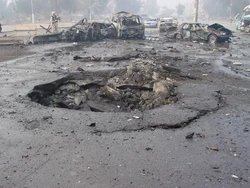
The result of a 2003 car bombing in Iraq. Suicide bombings in Iraq since 2003 have killed thousands of people, mostly Iraqi civilians, and arguably constitute a new phenomenon in the history of warfare. Suicide bombings have been used as a tactic in other armed struggles, but their frequency and lethality in Iraq is unprecedented. Even a relatively small blast can cause a over-pressure shock wave, burns and shrapnel.
Secondary injuries are caused by Fragmentation and other objects propelled by the explosion. Fragmentation is produced by the acceleration of shattered pieces of bomb casing and adjacent physical objects. The use of fragmentation in bombs dates to the 14th century, and appears in the Ming Dynasty text Huolongjing. The fragmentation bombs were filled with iron pellets and pieces of broken porcelain. Once the bomb explodes, the resulting shrapnel is capable of piercing the skin and blinding enemy soldiers.
While conventionally viewed as small metal shards moving at super-supersonic and hypersonic speeds, fragmentation can occur in epic proportions and travel for extensive distances. When the S.S. Grandcamp exploded in the Texas City Disaster on April 16, 1947, one fragment of that blast was a two-ton anchor which was hurled nearly two miles inland to embed itself in the parking lot of the Pan American refinery. Fragmentation should not be confused with shrapnel, which relies on the momentum of a shell to cause damage.
Officially 'Shrapnel' refers to the pieces of a bomb, shell, or bullet that has exploded out ward, or thrown debrois with in (ie: tungsten balls, nails, etc) with the intended design of fragmentation as a weapon of war. During wars, many soldiers are treated for shrapnel wounds. When people are injured or killed by bombs, many of them are hurt by flying shrapnel, that is- sharp, dangerous shards of metal. At all bomb blasts there are other things like shattered glass from a blasted-out windows and wood from broken furniture.
These injuries may affect any part of the body and sometimes result in penetrating trauma with visible bleeding. At times the projectile (a blast trown/ propelled object may become embedded in the body, obstructing the loss of blood to the outside. However, there may be extensive blood loss within the body cavities. Fragmentation wounds may be lethal and therefore many anti-personnel bombs are designed to generate fragments.
Most casualties are caused by secondary injuries as generally a larger geographic area is affected by this form of injury than the primary blast site as debris can easily be propelled for hundreds to thousands of meters. Some explosives, such as in nail bombs, are deliberately designed to increase the likelihood of secondary injuries. In other instances, the target provides the raw material for the objects thrown into people, e.g., shattered glass from a blasted-out window or the glass facade of a building or wood from broken furniture.
Shrapnel shells were anti-personnel artillery munitions which carried a large number of individual bullets close to the target and then ejected them to allow them to continue along the shell's trajectory and strike the target individually. They relied almost entirely on the shell's velocity for their lethality. The munition has been obsolete since the end of World War I for anti-personnel use, when it was superseded by high-explosive shells for that role. The functioning and principles behind Shrapnel shells are fundamentally different from high-explosive shell fragmentation, which it is now commenly included with.
Shrapnel is named after Major-General Henry Shrapnel (1761–1842), a British artillery officer, whose experiments, initially conducted in his own time and at his own expense, culminated in the design and development of a new type of artillery shell.
Quaternary injuries
Quaternary injuries, or other miscellaneous named injuries, are all other injuries not included in the first three classes. These include flash burns, crush syndrome from crush injuries and respiratory injuries.
Traumatic amputations quickly result in death, and are thus rare in survivors, and are often accompanied by significant other injuries. The rate of eye injury may depend on the type of blast. Psychiatric injury, some of which may be caused by neurological damage incurred during the blast, is the most common quaternary injury, and post-traumatic stress disorder may affect people who are otherwise completely uninjured.
Immediate atomic results
Flash blinding
Flash blindness is visual impairment during and following exposure to a light flash of extremely high intensity. It may last for a few seconds to a few minutes.
For example, in everyday life, the subject of a flash photograph can be temporarily flash blinded. The bright light overwhelms the eye and only gradually fades. A bright spot or spots may be seen for many minutes. This phenomenon is leveraged in non-lethal weapons such as flash grenades and laser dazzlers.
Flash blindness is caused by bleaching (oversaturation) of the retinal pigment. As the pigment returns to normal, so too does sight. In daylight the eye's pupil constricts, thus reducing the amount of light entering after a flash. At night, the dark-adapted pupil is wide open so flash blindness has a greater effect and lasts longer.
A 1-megaton explosion can cause flash blindness at distances as great as 13 miles on a clear day, or 53 miles on a clear night. Retinal injury is the most far-reaching injury in such a incident.
Electromagnetic Pulse (EMP) damage
An electromagnetic pulse (Aka- transient electromagnetic disturbance) is a short burst of natural or artificial electromagnetic radiation. The term 'Electromagnetic pulse' is commonly abbreviated as E.M.P. and refers to a Electromagnetic phenomenon akin to static electricity, the hissing made on analogue radios by an unshielded motor and lightning. It may occur in the form of a radiated, electric or magnetic field or conducted electrical current depending on the natural or man made source.
Nuclear explosions create a characteristic pulse of electromagnetic radiation called a Nuclear EMP or NEMP. When a nuclear warhead detonated several hundreds of kilometres above the Earth's surface is known as a high-altitude electromagnetic pulse (HEMP) device, but it's effectiveness depends on factors including the altitude of the detonation, energy yield, gamma ray output, interactions with the Earth's magnetic field and electromagnetic shielding of targets. The HEMP acronym often being pronounced as one syllable. EMP interference is generally more disruptive or damaging to integrated circuits than vacuum tubes (valves).
It can kill satellites, TVs, transformers, computers, etc... Exploding nukes also cause it, especially when done in the outer atmosphere. Several satellites inadvertently damaged or destroyed by the in the Starfish Prime high-altitude nuclear test of July 9, 1962, and subsequent long turn temporary radiation belt.
- 25 rad: lowest dose to cause clinically observable blood changes.
- 200 rad: local dose for onset of erythema in humans.
- 400 rad: whole body LD50 for acute radiation syndrome in humans.
- 1 krad: typical radiation tolerance of ordinary microchips.
- 4 to 8 krad: typical radiotherapy dose, locally applied.
- 10 krad: fatal whole-body dose in 1964 Wood River Junction criticality accident.
- 1 Mrad: typical tolerance of radiation-hardened microchips.
Radiation and ionizing radiation par-sea
Neutron radiation, alpha radiation, and extremely energetic gamma (> ~20 MeV) can cause nuclear transmutation and induced radioactivity. The relevant mechanisms are neutron activation, alpha absorption, and photodisintegration. A large enough number of transmutations can change macroscopic properties and cause targets to become radioactive themselves, even after the original source is removed.
Acute radiation syndrome (ARS), also known as radiation poisoning, radiation sickness or radiation toxicity, is a collection of health effects which present within 24 hours of exposure to high amounts of ionizing radiation.
500 rem radiation dose; without medical treatment, there can be expected between 50% and 90% mortality from acute effects alone. Dying takes between several hours and several weeks.
On living things and people in general
In general, ionizing radiation is harmful and potentially lethal to living beings but can have health benefits in radiation therapy for the treatment of cancer and thyrotoxicosis.
Most adverse health effects of radiation exposure may be grouped in two general categories:
- Deterministic effects (harmful tissue reactions) due in large part to the killing/ malfunction of cells following high doses; and
- Stochastic effects, i.e., cancer and heritable effects involving either cancer development in exposed individuals owing to mutation of somatic cells or heritable disease in their offspring owing to mutation of reproductive (germ) cells.
Its most common impact is the stochastic radiation-induced cancer with a latent period of years or decades after exposure. The mechanism by which this occurs is well understood, but quantitative models predicting the level of risk remain controversial. The most widely accepted model posits that the incidence of cancers due to ionizing radiation increases linearly with effective radiation dose at a rate of 5.5% per sievert. If this Linear no-threshold model is correct, then natural background radiation is the most hazardous source of radiation to general public health, followed by medical imaging as a close second. Other stochastic effects of ionizing radiation are teratogenesis, Radiation-induced cognitive decline ad dementure, and heart disease.
Human symptoms of radiation sickness\syndrome\poisoning
- General symptoms: They include nausea and vomiting, headaches, fatigue, fever, hair loss and short period of skin reddening.
- Hematopoietic. This syndrome is marked by a drop in the number of blood cells, called aplastic anemia. This may result in infections due to a low amount of white blood cells, bleeding due to a lack of platelets, and anemia due to few red blood cells in the circulation. These changes can be detected by blood tests after receiving a whole-body acute dose as low as 0.25 Gy, though they might never be felt by the patient if the dose is below 1 Gy. Conventional trauma and burns resulting from a bomb blast are complicated by the poor wound healing caused by hematopoietic syndrome, increasing mortality.
- Gastrointestinal. This syndrome often follows absorbed doses of 6–30 Gy (600–3000 rad). The signs and symptoms of this form of radiation injury include nausea, vomiting, loss of appetite, and abdominal pain. Vomiting in this time-frame is a marker for whole body exposures that are in the fatal range above 4 Gy. Without exotic treatment such as bone marrow transplant, death with this dose is common. The death is generally more due to infection than gastrointestinal dysfunction.
- Neurovascular. This syndrome typically occurs at absorbed doses greater than 30 Gy (3000 rad), though it may occur at 10 Gy (1000 rad). It presents with neurological symptoms such as dizziness, headache, or decreased level of consciousness, occurring within minutes to a few hours, and with an absence of vomiting. It is invariably fatal.
According to the ICRP model, someone who spent 20 years inside the capitol building would have an extra one in a thousand chance of getting cancer, over and above any other existing risk. (20 yr × 85 mrem/yr × 0.001 rem/mrem × 0.055%/rem = ~0.1%) That "existing risk" is much higher; an average person would have a one in ten chance of getting cancer during this same 20-year period, even without any exposure to artificial radiation. One rem carries with it a 0.055% chance of causing cancer.
On objects
Radiation may affect materials and devices in deleterious ways:
- By causing the materials to induced in to becomeing radioactive (mainly by neutron activation, or in presence of high-energy gamma radiation by photodisintegration).
- By nuclear transmutation of the elements within the material including, for example, the production of Hydrogen and Helium which can in turn alter the mechanical properties of the materials and cause swelling and embrittlement.
- By radiolysis (breaking chemical bonds) within the material, which can weaken it, cause it to swell, polymerize, promote corrosion, cause belittlements, promote cracking or otherwise change its desirable mechanical, optical, or electronic properties.
- By formation of reactive compounds, affecting other materials (e.g. ozone cracking by ozone formed by ionization of air).
- By ionization, causing electrical breakdown, particularly in semiconductors employed in electronic equipment, with subsequent currents introducing operation errors or even permanently damaging the devices. Devices intended for high radiation environments such as the nuclear industry and extra atmospheric (space) applications may be made radiation hard with heavy shielding to resist such effects through design, material selection, and fabrication methods.
Many of the radiation effects on materials are produced by collision cascades and covered by radiation chemistry.
On gases and water
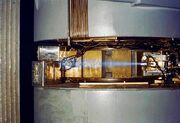
Ionized air glows blue around a beam of particulate ionizing radiation from a American cyclotron in 1939.
When water subjected to ionizing radiation forms free radicals of hydrogen and hydroxyl, which can recombine to form gaseous hydrogen, oxygen, hydrogen peroxide, hydroxyl radicals, and peroxide radicals. In living organisms, which are composed mostly of water, majority of the damage is caused by the reactive oxygen species, free radicals produced from water. The free radicals attack the biomolecules forming structures within the cells, causing oxidative stress (a cumulative damage which may be significant enough to cause the cell death, or may cause DNA damage possibly leading to cancer).
Exposure to radiation causes chemical changes in gases. The least susceptible to damage are noble gases, where the major concern is the nuclear transmutation with follow-up chemical reactions of the nuclear reaction products.
High-intensity ionizing radiation in air can produce a visible ionized air glow of telltale bluish-purplish color. The glow can be observed e.g. during criticality accidents, around mushroom clouds shortly after a nuclear explosion, or inside of a damaged nuclear reactor like during the Chernobyl disaster.
Significant amounts of ozone can be produced. Even small amounts of ozone can cause ozone cracking in many polymers over time, in addition to the damage by the radiation itself.
On electrical circuits
Ionization of materials temporarily increases their conductivity, potentially permitting damaging current levels. This is a particular hazard in semiconductor microelectronics employed in electronic equipment, with subsequent currents introducing operation errors or even permanently damaging the devices. Devices intended for high radiation environments such as the nuclear industry and extra atmospheric (in outer space) applications may be made radiation hard to resist such effects through design, material selection, and fabrication methods.
Proton radiation found in space can also cause single-event upsets in digital circuits.
The Geiger-Muller counter
The electrical effects of ionizing radiation are exploited in gas-filled radiation detectors, like the Geiger-Muller counter or the ion chamber.
Intermediate results
Epidemics, starvation and famine
Major epidemics, starvation and famine would occur in it's wake for various reasons. They would occur as a result of all the deaths, injuries, water and food contamination, poor sanitation, decomposing corpses and material losses directly from and also shortly after the event had occurred. As food ran short people became desperate and resorted rioting or looting.Hundreds of thousands will die off rapidly, when food gets short. Tensions get made worse by the fighting over what there is!
"What, no Baghdad?!"
An exiled Baghdadi in French based opposition think tank coin the turm in the late 1970's. It was basically a way of highlighting the losses caused to Iraq if it got sucked in to a violent and possibly atomic East-West war. Baghdad was a very provable target in such a war. He meant it as a warning both to Iraq and the world.
Baghdad is the capital of the Republic of Iraq. The population of Baghdad, as of 2011, is approximately 7,216,040, making it the largest city in Iraq, the second largest city in the Arab world, and the second largest city in Western Asia. As of 2012, Baghdad was listed as one of the least hospitable places in the world to live and was ranked by Mercer as the worst of 221 major cities as measured by quality-of-life.
- Baghdad's stats-
- Area: 204.2 km²
- Elevation: 34 m
- Weather: 12°C, Wind NW at 7 mph (11 km/h), 62% Humidity (15/02/2016).
- Local time: Tuesday 00:23 (Persian Gulf time zone)
- Flights from London to Baghdad: 9 h 50 min flight.
- Population: 3.841 million (1987) UN data, 7,216,040, (2011) and 9,028,636 (2015).
- Established 762 AD
- Founded by: Abu Jafar al-Mansur
- Local government type: Mayor–council
- Local government body: Baghdad City Advisory Council.
- Mayor: Zekra Alwach
- Administrate rank: 1st level
- What would be lost as far as institutions and places-
- Al-Shaheed Monument
- Iraqi National Symphony Orchestra
- National Theater
- Music and Ballet School of Baghdad
- Institute of Fine Arts Baghdad.
- Radio Dijlah
- Baghdadi Museum
- National Museum of Iraq
- Baghdad Zoo
- Al-Kadhimiya Mosque
- Baghdad International
- University of Baghdad
- University of Technology, Iraq
- Al-Mustansiriya University
- Nahrain University
- Alrafidain University College
Long term results
Nuclear haze
It is a haze caused by smoke, fallout, ash, particulates, smoke, aerosols and vaporized stuff that would blot out the sun for several days to months, or even possibly, a years after a major atomic war. Many plants would die due to light starvation.
Nuclear darkness
A nuclear darkness is a hypothetical global nuclear war induced deep, and prolonged, dimming of daylight during a nuclear winter, akin to the nuclear haze.
Global dimming
Global dimming, global reduction in ground insolation (solar radiance), due to the atmospheric injection of aerosols from various sources.
Climatic effects
A study presented at the annual meeting of the American Geophysical Union in December 2006 found that even a small-scale, regional nuclear war could disrupt the global climate for a decade or more. In a regional nuclear conflict scenario where two opposing nations in the subtropics would each use 50 Atomic bombings of Hiroshima and Nagasaki\Hiroshima -sized nuclear weapons (about 20\15 kiloton each) on major populated centres, the researchers estimated as much as five million tons of soot would be released, which would produce a cooling of several degrees over large areas of North America and Eurasia , including most of the grain-growing regions. The cooling would last for years, and according to the research could be "catastrophic".
Nuclear\Atomic summer
A "nuclear summer" is a hypothesized scenario in which, after a nuclear winter has abated, a greenhouse effect then occurs due to CO2 released by combustion and methane released from the marsh gas via the decay of the organic matter that froze during the nuclear winter. It is supported scientifically far less, than nuclear winter, as a risk.
Ozone depletion
A 2008 study by Michael J. Mills and co-authors, published in the Proceedings of the National Academy of Science , found that a nuclear weapons exchange between Pakistan and India using their current arsenals could create a near-global ozone hole, triggering human health problems and causing environmental damage for at least a decade. The computer-modeling study looked at a nuclear war between the two countries involving 50 Hiroshima-sized nuclear devices on each side, producing massive urban fires and lofting as much as five million metric tons of soot about 50 miles into the mesosphere. The soot would absorb enough solar radiation to heat surrounding gases, causing a series of surface chemistry reactions that would break down the stratospheric ozone layer protecting Earth from harmful ultraviolet radiation.
Nuclear\Atomic Winter
A nuclear winter is a largely hypothetical global climatic effect of atomic war and related urban and\or natural wildfires that is most frequently suggested to follow after the combined combustion pollution from the burning of at least 100 city sized areas, at firestorm-intensity. It would be a deep, and prolonged, fall in temperature caused by the nuclear haze.
The Climate models that are in the public-domain, suggest that the ignition of 100 firestorms that are comparable in intensity to that observed in Hiroshima in 1945 would produce a threshold-level nuclear winter.
A lager event was the subject computer modellers in the 1980's that had it's operators coin. It was assumed to be a war with fires that would be ignited by any countervalue city-airburst nuclear weapon policy during a US-Soviet total war.
Michigan State University, Pennsylvania State University, The National Center for Atmospheric Research at Boulder, Colorado, the Defense Nuclear Agency, US Air Force Geophysics Laboratory, US Interagency Intelligence Assessment, the University of East Anglia Climatic Research Unit and Lawrence Livermore National Laboratory have all done several studies on this scenario.
The results stated-
- Cooling by about 20 °C in core agricultural regions of the US, Europe and China.
- Cooling by about 35 °C in Russia.
- Cooling by about 1°C in else-were.
- A 99% reduction in the natural solar radiation reaching the surface of the planet in the first few years, gradually clearing over several decades.
Nuclear darkness
A nuclear darkness is a hypothetical global nuclear war induced deep, and prolonged, dimming of daylight during a nuclear winter, akin to the nuclear haze.
Global dimming
Global dimming, global reduction in ground insolation (solar radiance), due to the atmospheric injection of aerosols from various sources.
Nuclear fallout and the Radio-chemistry of the fall out.
Nuclear fallout, atomic fallout, arial fallout; or simply 'fallout', is the residual radioactive material propelled into the upper atmosphere following a nuclear blast or a nuclear reaction conducted in an unshielded facility, so called because it "falls out" of the sky after the explosion and the shock wave have passed. It commonly refers to the radioactive dust and ash created when a nuclear weapon explodes, but such dust can also originate from a damaged nuclear plant. Fallout may take the form of black rain and\or pink snow (rain and snow darkened by particulates).
This radioactive dust, consisting of material either directly vaporized by a nuclear blast or charged by exposure, is a highly dangerous kind of radioactive contamination.
An air burst (that is, a nuclear detonation far above the surface) can eventually produce worldwide fallout. A ground burst can produce possibly much more severe, but local fallout.
Parts of the sea bottom may become fallout. After the Castle Bravo test, white dust—contaminated calcium oxide particles originating from pulverized and calcined corals—fell for several hours, causing beta burns and radiation exposure to the inhabitants of the nearby atolls and the crew of the Daigo Fukuryū Maru fishing boat. The scientists called the fallout "Bikini snow".
The "Ils ne sont pas touché le Pérou, mais les collines sont devenus toxiques." factor
IT was a term coined by a French scantest in the wake of the film Dr Stangelove to point out how it would drift around the world. In this case it went from a nuked USA and southern Canada on to the Andes Mountains (especially in Peru) after a period of just over a month.
Strontium-90
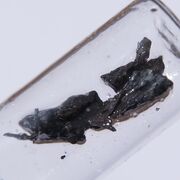
Strontium (Strontium-32 shown here) is very similar to calcium, but it is more heavy and reactive. For this metal and its compounds, only very few and special applications exist. Strontium salts are used to make red fireworks. Strontium is notorious for the radioactive 90Sr, which is produced in nuclear power plants as well as in atomic explosions like that in Chernobyl and from atomic bombs. This has a half-life of 29 years. It is build into bones like calcium and there causes cancer.
Strontium is a chemical element with symbol Sr and atomic number 38. An alkaline earth metal, strontium is a soft silver-white or yellowish metallic element that is highly reactive chemically. The metal turns yellow when it is exposed to air. Strontium was recognized as a new element in 1790 when Adair Crawford analyzed a mineral sample from a lead mine near Strontian, Scotland. The 90Sr isotope is present in radioactive fallout and has a half-life of 28.90 years. It is a classic element of atomic fall out clouds and ground zero contamination.
- Symbol: Sr
- Electron configuration: [Kr] 5s2
- Melting point: 768.8 °C
- Atomic number: 38
- Atomic mass: 87.62 u ± 0.01 u
- Discovered: 1790
- Discoverer: William Cruickshank
- Abundance earth’s crust: 370 parts per million by weight, 87 parts per million by moles
- Abundance solar system: 50 parts per billion by weight, 0.7 parts per billion by moles
- Cost, pure: $100 per 100g
- Cost, bulk: $? per 100g
CRT computer monitor front panel made from strontium and barium oxide-containing glass. This application used to consume most of the world's production of strontium. Strontium salts are added to fireworks in order to create red colors. Strontium carbonate and other strontium salts can be added to fireworks to give a deep red colour. This is the same effect that is used to identify strontium cations using the flame test. This application consumes about 5% of the world's production. Strontium-90 (90Sr) is also used in cancer therapy. Its beta emission and long half-life is ideal for superficial radiotherapy.
Scientists are testing strontium ranelate to see if it can be taken by mouth to treat thinning bones (osteoporosis). Radioactive strontium-89 is given intravenously (by IV) for prostate cancer and advanced bone cancer. Strontium chloride hexahydrate is added to toothpaste to reduce sensitive teeth. Strontium chloride is sometimes used in toothpastes for sensitive teeth. One popular brand includes 10% total strontium chloride hexahydrate by weight.
90Sr isotope is present in radioactive fallout and has a half-life of 28.90 years.
Strontium 91 has a half life 9.63 hours.
Strontium 92 has a half life 2.66 hours.
Strontium ltd strontiumltd.com/ is a company who's goal is to be "specialists in identifying and developing high growth potential small to medium sized companies. We focus and support these organisations to grow." It dose not use the metal or get involved in it despite of the company's name.
Polonium-210
Polonium is a chemical element with symbol Po and atomic number 84, discovered in 1898 by Marie Curie and Pierre Curie. They include heaters in space probes, antistatic devices, and sources of neutrons and alpha particles.
- Symbol: Po
- Electron configuration: [Xe] 6s24f145d106p4
- Atomic number: 84
- Discovered: 1898
- Atomic mass: 209 u
- Melting point: 253.8 °C
- Discoverers: Pierre Curie, Marie Curie
- Abundance earth’s crust: Of the order of 1 part per quadrillion.
- Abundance solar system: negligible
- 2015 cost, pure: ? per 100g
- 2015 cost, bulk: ? per 100g
Polonium-210 is a rare radioactive metal discovered by Marie Curie in the late 19th century. It has a half-life of 138 days (about 4.5 months), decaying down to lead. During its radioactive decay, polonium-210 emits alpha particles.
Polonium is a chemical element with symbol Po and atomic number 84, discovered in 1898 by Marie Curie and Pierre Curie. A rare and highly radioactive element with no stable isotopes, polonium is chemically similar to bismuth and tellurium, and it occurs in uranium ores.
The heavy metal is also, like nearly all heavy metals, very toxic and was used in the poisoning of the Russia defector, Alexander Litvinenko.
Plutonium-239
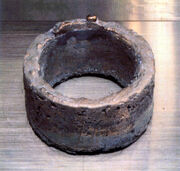
A weapons-grade ring of electrorefined plutonium, typical of the rings refined at Los Alamos and sent to Rocky Flats for fabrication. The ring has a purity of 99.96%, weighs 5.3 kg, and is approx 11 cm in diameter. It is enough plutonium for one bomb core. The ring shape helps with criticality safety (less concentrated material).
- Plutonium is a transuranic radioactive chemical element with symbol Pu and atomic number 94. It is an actinide metal of silvery-gray appearance that tarnishes when exposed to air, and forms a dull coating when oxidized.
- Symbol: Pu
- Atomic number: 94
- Electron configuration: [Rn] 5f67s2
- Atomic mass: 244 u
- Discovered: 1940
- Melting point: 639.4 °C
- Discoverers: Joseph W. Kennedy, Glenn T. Seaborg, Edwin McMillan, Arthur Wahl
- Abundance earth’s crust: negligible
- Abundance solar system: unknown
- 2015 Cost, pure: $4000 per gram
- 2015 Cost, bulk: per 100g
Early pacemaker batteries also used tiny amounts of plutonium-238.
Plutonium-239 emits Alpha radiation and has a half life of 24,000 years. That is for the time from now to the middle of the Upper Paleolithic (or Upper Palaeolithic, Late Stone Age) era. As a heavy metal, plutonium is also toxic.
Caesium-137
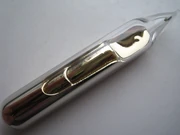
Cesium/Caesium metal(in a glass vessel to prevent oxidisation) from the Dennis s.k collection.
Caesium or cesium is a chemical element with symbol Cs and atomic number 55. It is a soft, silvery-gold alkali metal with a melting point of 28 °C, which makes it one of only five elemental metals that are liquid at or near room temperature. Handling it makes it runny and it reacts heavly in water with large amounts of it explodeing in water.
- Symbol: Cs
- Melting point: 28.44 °C
- Boiling point: 670.8 °C
- Electron configuration: [Xe] 6s1
- Atomic number: 55
- Discovered: 1860
- Descovered by: Robert Bunsen and physicist Gustav Kirchhoff
- Atomic mass: 132.90545 u ± 2 × 10^-7 u
- Abundance earth’s crust: 3 parts per million by weight, 0.5 parts per million by moles
- Abundance solar system: 8 parts per billion by weight, 70 parts per trillion by moles
- 2015 cost, pure: $1100 per 100g
- Cost, bulk: $ per 100g
Since the 1990s, the largest application of the element has been as caesium formate for drilling fluids. It has a range of applications in the production of electricity, in electronics, and in chemistry. The radioactive isotope caesium-137 has a half-life of about 30 years and is used in medical applications, industrial gauges, and hydrology. Although the element is only mildly toxic, it is a hazardous material as a very reactive metal and its radioisotopes present a high health risk if released into the environment.
In 1967, based on Einstein defining the speed of light as the most constant dimension in the universe, the International System of Units isolated two specific wave counts from an emission spectrum of caesium-133 to co-define the second and the meter. Since then, caesium has been widely used in highly accurate atomic clocks. Caesium compounds are also used as part of drilling fluids.
Cesium readily combines with oxygen and is used as a getter, a material that combines with and removes trace gases from vacuum tubes and photoelectric cells. This was a small-scale applications of the metal, since not much was ever used in any 1 valve. Cesium is also used in atomic clocks, in modern photoelectric cells and as a catalyst in the hydrogenation of certain organic compounds.
Cesium - WebGL Virtual Globe and Map Engine was named after the metal, not made from it. Their mission is "to create the leading web-based globe and map for visualizing dynamic data".Cesium Developer Networkcesiumjs.org. Cesium is an open source geospatial visualization JavaScript library https://cesium.agi.com/.
Cobalt-60
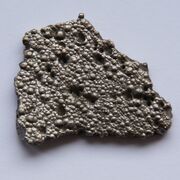
English: Cobalt, fraction of a cathode, 2 x 2 cm.
Cobalt is a chemical element with symbol Co and atomic number 27. Like nickel, cobalt in the Earth's crust is found only in chemically combined form, save for small deposits found in alloys of natural meteoric iron.
- Symbol: Co
- Electron configuration: [Ar] 3d74s2
- Atomic mass: 58.933195 u ± 0.000005 u
- Melting point: 1,495 °C
- Atomic number: 27
- Discovered: 1735
- Discoverer: Georg Brandt
- Abundance earth’s crust: 25 parts per million by weight, 8 parts per million by moles
- Abundance solar system: 4 parts per million by weight, 0.7 parts per million by moles
- 2015 cost, pure: $21 per 100g
- 2015 cost, bulk: $4.40 per 100g
Cobalt is primarily used as the metal, in the preparation of magnetic, wear-resistant and high-strength alloys. It is also used in phone and electric car batteries. Its compounds cobalt silicate and cobalt(II) aluminate (CoAl2O4, cobalt blue) give a distinctive deep blue color to glass, ceramics, inks, paints and varnishes. Cobalt occurs naturally as only one stable isotope, cobalt-59. Cobalt-60 is a commercially important radioisotope, used as a radioactive tracer and for the production of high energy gamma rays. Cobalt-60, 60Co, is a synthetic radioactive isotope of cobalt with a half-life of 5.2714 years.
Cobalt is the active center of coenzymes called cobalamins, the most common example of which is vitamin B12. As such it is an essential trace dietary mineral for all animals. Cobalt in inorganic form is also an active nutrient for bacteria, algae and fungi. It is toxic in very small amounts. names
- Strangely, cobalt has been used for several corporate names-
- Cobalt Light Systems https://www.cobaltlight.com/
- Developing innovative products & technologies for non-invasive, through barrier chemical analysis in security, pharmaceutical & research applications.
- Insight100 & Insight100M - LEDs bottle scanners https://www.cobaltlight.com/products/insight100series/
- The original bottle scanners from Cobalt, Insight100™ and Insight100M™ systems are widely deployed at EU airports, including 8 of the top 10 hubs.
- Cobalt Telephone Technologies for transactional and business use. www.ctt.co.uk/
- Cobalt Telephone Technologies builds innovative bespoke self-service environments for payments and transactions via smartphone, mobile and fixed phones.
- Cobalt health http://www.cobalthealth.co.uk/
- Information on medical services provided the by Cobalt Appeal Fund charity, including MRI, PET-CT and Breast scanning and Cancer Prevention services.
- Playcobalt http://playcobalt.com/
- Agame by Oxeye Game Studio in collaboration with Mojang and music by Anosou.
Uranium-235
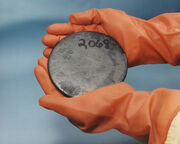
A billet of highly enriched uranium that was recovered from scrap processed at the Y-12 National Security Complex Plant.
Uranium is a chemical element with symbol U and atomic number 92. It is a silvery-white metal in the actinide series of the periodic table. A uranium atom has 92 protons and 92 electrons, of which 6 are valence electrons.
- Symbol: U
- Atomic number: 92
- Atomic mass: 238.02891 u ± 0.00003 u
- Discovered: 1789
- Electron configuration: [Rn] 5f36d17s2
- Melting point: 1,132 °C
- Discoverer: Martin Heinrich Klaproth
- Abundance earth’s crust: 2.7 parts per million by weight, 0.25 parts per million by moles
- Abundance solar system: 1 part per billion by weight, 4 parts per trillion by moles
- 2015 cost, pure: $? per 100g
- 2015 cost, bulk: $9 per 100g
Uranium is a very heavy metal which can be used as an abundant source of concentrated energy. The isotope U-235 is important because under certain conditions it can readily be split, yielding a lot of energy.
Commercial nuclear power plants use fuel that is typically enriched to around 3% uranium-235. Uranium metal is used for X-ray targets in the making of high-energy X-rays. Before (and, occasionally, after) the discovery of radioactivity, uranium was primarily used in small amounts for yellow glass and pottery glazes, such as uranium glass and in Fiestaware. U-238 can be converted into fissionable plutonium in breeder reactors. Depleted uranium (238U) is used in kinetic energy penetrators and armor plating.
Uranium-235 (235U) is an isotope of uranium making up about 0.72% of natural uranium. Unlike the predominant isotope uranium-238, it is fissile, i.e., it can sustain a fission chain reaction. It is the only fissile isotope that is a primordial nuclide or found in significant quantity in nature.
It has a half-life of 703.8 million years (roughly 3 times bigger than the time from the first Dinosaurs to today). It was discovered in 1935 by Arthur Jeffrey Dempster. Its (fission) nuclear cross section for slow thermal neutrons is about 584.994 barns. For fast neutrons it is on the order of 1 barn Most but not all neutron absorptions result in fission; a minority result in neutron capture forming uranium-236.
Uranium-238 is the most prevalent isotope in uranium ore, has a half-life of about 4.5 billion years; that is, half the atoms in any sample will decay in that amount of time.
Uranium-233 is a fissile isotope of uranium that is bred from thorium-232 as part of the thorium fuel cycle. It decays to 229Th and has a half life of 160,000 years.
Thorium-232
Thorium is a chemical element with symbol Th and atomic number 90. A radioactive actinide metal, thorium is one of only two significantly radioactive elements that still occur naturally in large quantities as a primordial element.
- Symbol: Th
- Atomic number: 90
- Electron configuration: [Rn] 6d27s2
- Atomic mass: 232.03806 u ± 0.00002 u
- Discovered: 1828
- Descoverd by: Jöns Jakob Berzelius
- Melting point: 1,755 °C
- Boiling point: 4,787 °C
- Abundance earth’s crust: 6 parts per million by weight, 0.5 parts per million by moles
- Abundance solar system: 0.3 parts per billion by weight, 2 parts per trillion by moles
- Cost, pure: ?$ per 100g
- Cost, bulk: ?$ per 100g
Thorium-232, half life 14 Billion years, which is about ~3 times longer than the planet Earth has existed for and about twice the time the Universe has existed for.
Thorium was once commonly used as the light source in gas mantles and as an alloying material, but these applications have declined due to concerns about its radioactivity. Thorium is still widely used as an alloying element in TIG welding electrodes (at a rate of 1%-2% mix with tungsten). It remains popular as a material in high-end optics and scientific instrumentation; thorium and uranium are the only significantly radioactive elements with major commercial applications that do not rely on their radioactivity. Thorium is predicted to be able to replace uranium as nuclear fuel in nuclear reactors, but only a few proto-type thorium reactors have yet been completed.
Thorium is a toxic heavy metal.
Tritium (symbol T or 3H, also known as hydrogen-3)

Radioluminescent 1.8 curies (67 GBq) 6 by 0.2 inches (152.4 mm × 5.1 mm) tritium vials are thin, tritium-gas-filled glass vials whose inner surfaces are coated with a phosphor. The vial shown here is brand-new.
Tritium (/ˈtrɪtiəm/ or /ˈtrɪʃiəm/; symbol T or 3H, also known as hydrogen-3) is a radioactive isotope of hydrogen. The nucleus of tritium (sometimes called a triton) contains one proton and two neutrons, whereas the nucleus of protium (by far the most abundant hydrogen isotope) contains one proton and no neutrons. Naturally occurring tritium is extremely rare on Earth, where trace amounts are formed by the interaction of the atmosphere with cosmic rays. The name of this isotope is formed from the Greek word τρίτος (trítos) meaning "third". The normal Hydrogen isotope is a chemical element with chemical symbol H and atomic number 1. With an atomic weight of 1.00794 u, hydrogen is the lightest element on the periodic table.
Naturally occurring tritium is extremely rare on Earth, where trace amounts are formed by the interaction of the atmosphere with cosmic rays. The name of this isotope is formed from the Greek word τρίτος (trítos) meaning "third".
Tritium illumination is the use of gaseous tritium, a radioactive isotope of hydrogen, to create visible light. Tritium emits electrons through beta decay, and, when they interact with a phosphor material, fluorescent light is created, a process called radioluminescence. As based tritium illumination requires no electrical energy, it found wide use in applications such as emergency exit signs and illumination of wristwatches. More recently, many applications using radioactive materials have been replaced with photoluminescent materials.
The low energy of tritium's radiation makes it difficult to detect tritium-labeled compounds except by using liquid scintillation counting.
- Tritium data
- Symbol triton,3H
- Neutrons 2
- Protons 1
- Natural abundance trace
- Half-life 12.32 years
- Decay products 3He
- Isotope mass 3.0160492 u
- Spin 1⁄2
- Excess energy 14,949.794± 0.001 keV
- Binding energy 8,481.821± 0.004 keV
- Decay mode Decay energy
- Beta emission 0.018590 MeV
Hydrogen is a chemical element with chemical symbol H and atomic number 1. With an atomic weight of 1.00794 u, hydrogen is the lightest element on the periodic table. Its monatomic form (H) is the most abundant chemical substance in the Universe, constituting roughly 75% of all baryonic mass. Non-remnant stars are mainly composed of hydrogen in its plasma state. The most common isotope of hydrogen, termed protium (name rarely used, symbol 1H), has one proton and no neutrons.
The universal emergence of atomic hydrogen first occurred during the recombination epoch. At standard temperature and pressure, hydrogen is a colorless, odorless, tasteless, non-toxic, nonmetallic, highly combustible diatomic gas with the molecular formula H2. Since hydrogen readily forms covalent compounds with most non-metallic elements, most of the hydrogen on Earth exists in molecular forms such as in the form of water or organic compounds. Hydrogen plays a particularly important role in acid–base reactions as many acid-base reactions involve the exchange of protons between soluble molecules. In ionic compounds, hydrogen can take the form of a negative charge (i.e., anion) when it is known as a hydride, or as a positively charged (i.e., cation) species denoted by the symbol H+. The hydrogen cation is written as though composed of a bare proton, but in reality, hydrogen cations in ionic compounds are always more complex species than that would suggest. As the only neutral atom for which the Schrödinger equation can be solved analytically, study of the energetics and bonding of the hydrogen atom has played a key role in the development of quantum mechanics.
- Hydrogen data
- Symbol: H
- Atomic mass: 1.008 u ± 0.00001 u
- Atomic number: 1
- Melting point: -259.2 °C
- Boiling point: -252.9 °C
- Discovered: 1766
- Discovery: Henry Cavendish
- Electron configuration: 1s1, per shell: 1
- Abundance earth’s crust: 1400 parts per million by weight (0.14%), 2.9% by moles
- Abundance solar system: 75% by weight, 93% by moles
- Cost, pure: $12 per 100g
- Cost, bulk: $? per 100g
According to the U.S. EPA, "a recently documented source of tritium in the environment is [self-illuminating] exit signs that have been illegally disposed of in municipal landfills. Water, which seeps through the landfill, is contaminated with tritium from broken signs and can pass into water ways, carrying the tritium with it."
Tritium is a classic of atomic fall out with a half life of 12.32 years, but since it is a gas it will blow away and disperses in to the air rather than fall out of the sky. Tritium has leaked from 48 of 65 nuclear sites in the US. In one case, leaking water contained 7.5 microcuries (0.28 MBq) of tritium per litre, which is 375 times the EPA limit for drinking water.
The US Nuclear Regulatory Commission states that in normal operation in 2003, 56 pressurized water reactors released 40,600 curies (1.50 PBq) of tritium (maximum: 2,080; minimum: 0.1; average: 725) and 24 boiling water reactors released 665 curies (24.6 TBq) (maximum: 174; minimum: 0; average: 27.7), in liquid effluents.
The high levels of atmospheric nuclear weapons testing that took place prior to the enactment of the Partial Test Ban Treaty proved to be unexpectedly useful to oceanographers. The high levels of tritium oxide introduced into upper layers of the oceans have been used in the years since then to measure the rate of mixing of the upper layers of the oceans with their lower levels.
Krypton-85

Image of a krypton filled discharge tube shaped like the element’s atomic symbol. Attribution: Pslawinski.
Krypton is a gaseous chemical element with symbol Kr and atomic number 36. It is a member of group 18 elements.
Krypton has an important role in production and usage of the krypton fluoride laser. The laser has been important in the nuclear fusion energy research community in confinement experiments. The laser has high beam uniformity, short wavelength, and the ability to modify the spot size to track an imploding pellet.
- Symbol: Kr
- Boiling point: -153.2 °C
- Electron configuration: [Ar] 3d104s24p6
- Melting point: -157.4 °C
- Atomic number: 36
- Atomic mass: 83.798 u
- Discvoered in: 1898
- Discovered by: Morris Travers and William Ramsay
- Abundance earth’s crust: 100 parts per trillion by #weight, 30 parts per trillion by moles
- Abundance solar system: parts per million by weight, parts per million by moles
- Cost, pure: $33 per 100g
- Cost, bulk: $ per 100g
Naturally occurring krypton is made of six stable isotopes. In addition, about thirty unstable isotopes and isomers are known. 81Kr, the product of atmospheric reactions, is produced with the other naturally occurring isotopes of krypton. Being radioactive, it has a half-life of 230,000 years. Krypton is highly volatile when it is near surface waters, but 81Kr has been used for dating old (50,000–800,000 years) groundwater.
85Kr is an inert radioactive noble gas with a half-life of 10.76 years. It is produced by the fission of uranium and plutonium, such as in nuclear bomb testing and nuclear reactors. 85Kr is released during the reprocessing of fuel rods from nuclear reactors. Concentrations at the North Pole are 30% higher than at the South Pole due to convective mixing.
It is a classic element of atomic fall out with a half life of 10.756 years, but since it is a gas it will blow away and disperses in to the air rather than fall out of the sky.
Iodine-131

A sample of iodine.
Iodine is a chemical element with symbol I and atomic number 53. The name is from Greek ἰοειδής ioeidēs, meaning violet or purple, due to the color of iodine vapor.
- Symbol: I.
- Melting point: 113.7 °C.
- Boiling point: 184.3 °C.
- Electron configuration: [Kr] 4d105s25p5.
- Atomic mass: 126.90447 u.
- Atomic number: 53.
- Discovery by: Bernard Courtois
- Date of discovery: 1811.
- Abundance earth’s crust: 450 parts per billion by weight, 73 parts per billion by moles
- Abundance solar system: parts per billion by weight, parts per billion by moles
- Cost, pure: $8.3 per 100g
- Cost, bulk: ?$ per 100g
Iodine and its compounds are primarily used in nutrition, and industrially in the production of acetic acid and certain polymers. Iodine's relatively high atomic number, low toxicity, and ease of attachment to organic compounds have made it a part of many X-ray contrast materials in modern medicine. Iodine has only one stable isotope. Iodine radioisotopes, such as 131I, are also used in medical applications.
Iodine-131, is an important radioisotope of iodine discovered by Glenn Seaborg and John Livingood in 1938 at the University of California, Berkeley. It has a radioactive decay half-life of about eight days.
Radioactive Iodine I-131 (also called Radioiodine I-131) therapy is a treatment for an overactive thyroid, a condition called hyperthyroidism.
It is a classic element of atomic fall out with a half life of 8.0197 days.
Zirconium 97
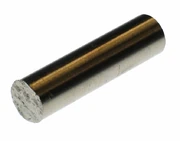
A Zirconium rod. Image taken by User:Dschwen.
Zirconium is a chemical element with symbol Zr and atomic number 40. The name of zirconium is taken from the name of the mineral zircon, the most important source of zirconium.
Zirconium is a lustrous, greyish-white, soft, ductile and malleable metal which is solid at room temperature, though it becomes hard and brittle at lower purities. In powder form, zirconium is highly flammable, but the solid form is far less prone to ignition. Zirconium is highly resistant to corrosion by alkalis, acids, salt water and other agents. However, it will dissolve in hydrochloric and sulfuric acid, especially when fluorine is present. Alloys with zinc become magnetic below 35 K.
- Symbol: Zr
- Electron configuration: [Kr] 4d25s2
- Discovered: 1789
- Atomic number: 40
- Atomic mass: 91.224 u ± 0.002 u
- Melting point 2128 K (1855 °C, 3371 °F)
- Boiling point 4650 K (4377 °C, 7911 °F)
- Discoverer: Martin Heinrich Klaproth
- Abundance earth’s crust: 165 parts per million by weight, 38 parts per million by moles
- Abundance solar system: 40 parts per billion by weight, 0.5 parts per billion by moles
- Cost, pure: $157 per 100g
- Cost, bulk: $16 per 100g
Zirconium has a concentration of about 130 mg/kg within the Earth's crust and about 0.026 μg/L in sea water. It is not found in nature as a native metal, reflecting its intrinsic instability with respect to water. The principal commercial source of zirconium is zircon (ZrSiO4), a silicate mineral, which is found primarily in Australia, Brazil, India, Russia, South Africa and the United States, as well as in smaller deposits around the world. As of 2013, two-thirds of zircon mining occurs in Australia and South Africa. Zircon resources exceed 60 million tonnes worldwide and annual worldwide zirconium production is approximately 900,000 tonnes. Zirconium also occurs in more than 140 other minerals, including the commercially useful ores baddeleyite and kosnarite.
Zr is relatively abundant in S-type stars, and it has been detected in the sun and in meteorites. Lunar rock samples brought back from several Apollo program missions to the moon have a quite high zirconium oxide content relative to terrestrial rocks.
It is a classic element of atomic fall out with a half life of 16.744 hours.
Zirconium 95 has a half life of 64.02 days.
The British Zircon signals intelligence satellite was named after the mineral Zirconium is extracted from, not made out of the mineral it's self.
Antimony 131
Antimony 131 has a half-life of 23.03 minuets.
Molybdenum 99
Molybdenum 99 has a half-life of 2.7489 days.
Ruthenium 106
Ruthenium 106 (106Ru) has a half-life of 373.59 days.
Lanthanum 141
lanthanum 141 has a half-life of 3.92 hours.
Tellurium 132
Tellurium 132 has a half-life of 3.204.
Tellurium 134 has a half-life of 41.8.
Barium 140
Barium 140 has a half-life of 12.752 days.
Cerium 137
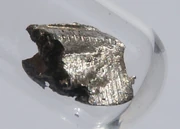
1.5 grams of ultrapure cerium under argon. Original size in cm: 1 x 1.
Cerium is a chemical element with symbol Ce and atomic number 58. It is a soft, silvery, ductile metal which easily oxidizes in air. Cerium was named after the dwarf planet Ceres.
- Symbol: Ce
- Electron configuration: [Xe] 4f15d16s2
- Discovered: 1803
- Atomic number: 58
- Atomic mass: 140.116 u ± 0.001 u
- Boiling point: 3,443 °C
- Melting point: 795 °C
- Discovery: Martin Heinrich Klaproth, Jöns Jakob Berzelius, Wilhelm Hisinger (1803)
- Abundance earth’s crust: 60 parts per million by weight, 8.9 parts per million by moles
- Abundance solar system: 4 parts per billion by weight, 30 parts per trillion by moles
- Cost, pure: $380 per 100g
- Cost, bulk: $1.20 per 100g
Cerium is a chemical element with symbol Ce and atomic number 58. It is a soft, silvery, ductile metal which easily oxidizes in air. Cerium was named after the dwarf planet Ceres (itself named after the Roman goddess of agriculture). Cerium is the most abundant of the rare earth elements, making up about 0.0046% of the Earth's crust by weight. It is found in a number of minerals, the most important being monazite and bastnäsite. Commercial applications of cerium are numerous. They include catalysts, additives to fuel to reduce emissions and to glass and enamels to change their color. Cerium oxide is an important component of glass polishing powders and phosphors used in screens and fluorescent lamps. It is also used in the "flint" (actually ferrocerium) of lighters.
Cerium was named for the asteroid Ceres, which was discovered in 1801 and named after a Roman god of that name.
It is the most abundant of the rare earth metals and is found in minerals including allanite, monazite, cerite, and bastnaesite. There are large deposits found in India, Brazil and the USA, thus giving them much industrial/political leverage on the world. Monazite deposits are located in Australia, Brazil, China, India, Malaysia, South Africa, Sri Lanka, Thailand, and the United States. Norway and Sweden used to be minor and historic sources.
Mischmetal (English: Mixed-metal) is an alloy of about 50% cerium, 25% lanthanum, 15% neodymium and 10%praseodymium, plus trace amounts of other rare-earth metals and iron. It is used as a deoxidizer in various alloys and vacuum tubes. By alloying it in to magnesium, it contributes to both high strength and creep resistance.
Cerium 137 has a half-life of 9 days.
Cerium 144 has a half-life of 284.91 days.
Strangely www.ceriumoptical.com uses the name, but dose not sell the metal since it's an optics firm. As they say "Cerium was founded in 1971, first as a distributor, then as a manufacturer of high-grade optical products." http://www.ceriumoptical.com/ and http://www.ceriumoptical.com/group.aspx
An aluminium greenhouse frame-come aluminium 26 (26Al)?
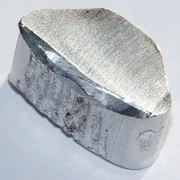
A chunk of aluminium, 2.6 grams, 1 x 2 cm. Author- http://images-of-elements.com/aluminium.php
- Symbol: Al
- Melting point: 660.3 °C
- Electron configuration: [Ne] 3s23p1
- Atomic mass: 26.981539 u ± 8 × 10^-7 u
- Boiling point: 2,519 °C
- Atomic number: 13
- Discovered: 1825
- Discovered by: Hans Christian Ørsted
- Abundance earth’s crust: 8.23 % by weight, 6.32 % by moles
- Abundance solar system: 56 ppm by weight, 2.7 ppm by moles
- Cost, pure: $15.72 per 100g
- Cost, bulk: $0.20 per 100g
Some other things like water and some metals will also become radioactive due to the initial blast ionizing radiation. I chose an aluminium greenhouse frame for an example.
It is used in an extensive range of products from drinks cans, window frames, cooking pans, pace satellites, greenhouse frames, boats and aircraft. A Boeing 747-400 contains 147,000 pounds (66,150 kg) of high-strength aluminum. Only iron is used more widely than aluminum. It has no taste or smell. Aluminium is also slightly toxic which may make cuts and wounds with freshly polished and cut aluminium may cause a festering type allergic reason after a few days if it is not cleaned out. Heavy\continued ingestion of it may cause alzheimer’s disease.
Aluminium 26 has a half-life 720,000 years. That is for the time from now to when the people who lived near the Zhoukoudian region of Beijing master the skill of using fire in the early Paleolithic Period (the early stone-age).
Fall out shelters and atomic\nuclear bunkers
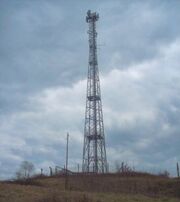
Kelvedon Hatch emergency broadcast tower, which would have transmitted official announcements after a nuclear attack on the UK. English: Radio Antenna at Kelvedon Hatch (M. Kenyon), ~31 May 2007.
Government would have limped on from places like Kelvedon Hatch Secret Nuclear Bunker and RAF Hack Green. Valuable members of the public, the armed forces and some critical industries would also be protected to a degree, but most would have perished!
No doubt some places would survive and in time form small principality and city states like this S.E. Polish one, The Republic of Mount Tarnica, which I made on another wiki.
Other known issues
Earthquakes and seismology
All very large explosions, including nukes, make a small earth tremor; but if a larger nuke could set of a near by major fault-line. This is both banned by the UN and denounced by all governments.
The ionosphere\Van Allen Belt
The day before Telstar 1 launched, a U.S. high-altitude nuclear bomb (called the Starfish Prime high-altitude nuclear test) had energized the Earth's Van Allen Belt where Telstar 1 went into orbit. This vast increase in a partly artificial radiation belts, combined with subsequent high-altitude blasts, including a Soviet test in October, overwhelmed Telstar's fragile transistors and shorted some out. It went out of service in November 1962, after handling over 400 telephone, telegraph, facsimile and television transmissions. Some electrical systems such as street lights, phones and microwave relay stations also failed in Hawaii and New Zealand because of it!
The Soviet's Tsar Bomba bast on October 30, 1961, also caused a 1 hour local radio jamming effect due to the initial ionised radiation output.
Tidal-waves\tsunamis and toxic seas

HD tsunami bomb underwater nuclear explosion 1958 operation hardtack-1
you can see how powerful of atomic bomb detonated underwater,this is a footage from 1958 operation hardtack. The USA, S. Africa, UK, NZ and the USSR had toyed with the idea of a Tsunami bomb in the mid 1940s and early 1950s.
The USA, S. Africa, UK, NZ, Mouist China and the USSR had toyed with the idea of a Tsunami bomb in the mid 1940s and again in the early 1950s, because it was theoretically possible to Tsunami and tide waves with the under water shock-wave caused by a exploding nuke. Only relitvly minor ones have occurred on tests so far.
The sea around the detonation site would also become temporarily radioactive until the contaminated water had been swept away by the ocean currents.
The Dead Hand System
The Dead Hand (or "Perimeter") system built by the Soviet Union (circa mid 1970s) during the Cold War has been called a "doomsday machine" due to its fail-deadly design and nuclear capabilities (launching all missiles randomly across the world outside of USSR and it's allies, thus de facto bringing about even there own destruction (sick, or what)! Gorbachove hated it, Yelstin closed it down, but Putin has rengaged it according to Western media reports. Nikita Khrushchev reportedly did not agree with such a response when the theory emerged in the late 1950's since he thought it was a genocidal idea that would kill innocence neutrals and any commies who the West had not managed to conquer!
Project Pluto
Project Pluto (The Flying Crowbar missile) was the insane doomsday weapon America almost built. It was a Cold War SLAM missile. SLAM stands for- Supersonic Low Altitude Missile, that means that this giant, nuclear-powered beast would be screaming around at low rooftop/tree top hight, spewing poisonose radiation as it went to the place it was to blow up with it's nuke (sick, or what)!
Doomsday device
A doomsday device is a hypothetical construction first considered in the mid 1950's — usually a weapon, or collection of weapons — which could destroy all life on a planet, particularly the Earth, or destroy the planet itself, bringing "doomsday", a term used for the end of planet Earth. Most hypothetical constructions rely on the fact that hydrogen bombs can be made arbitrarily large assuming there are no concerns about delivering them to a target (see Teller–Ulam design) or that they can be "salted" with materials designed to create long-lasting and hazardous fallout (e.g., a cobalt-50 or -60 type bomb. Sick, or what!).
A salted bomb should not be confused with a dirty bomb, which is an ordinary chemical explosive bomb containing radioactive material which is spread over the area when the bomb explodes. A salted bomb is able by desinge to contaminate a much larger area than a dirty bomb.
For many, the scheme epitomized the extremes of the suicidal logic behind the strategy of mutual assured destruction; the idea was famously parodied in the Stanley Kubrick film from 1964, Dr. Strangelove or: How I Learned to Stop Worrying and Love the Bomb.
Brezhnev made it in the 1970's, Yeltsin closed it down, but Putin has engaged it according to Western media reports. Nikita Khrushchev reportedly did not agree with such a device or devices when the theory emerged in the late 1950's since he thought it was a genocidal idea that would kill innocence neutrals and any commies who the West had not managed to conquer! Boris Yeltsin also hated it, according to western intelligence and media sources. Both Ike and JFK also thought such weapons were inhuman and un-American in it's nature.
Salted bombs
A salted bomb should not be confused with a dirty bomb, which is an ordinary chemical explosive bomb containing radioactive material which is spread over the area when the bomb explodes. A salted bomb is able by desinge to contaminate a much larger area than a dirty bomb.
A salted bomb is a nuclear weapon designed to function as a radiological weapon, producing enhanced quantities of radioactive fallout, rendering a large area uninhabitable. The term is derived both from the means of their manufacture, which involves the incorporation of additional elements to a standard atomic weapon, and from the expression "to salt the earth", meaning to render an area uninhabitable for generations. It was coined in ancient times since Roma and Greece put salt in the ground of attacked nations to ruin it. The idea originated with Hungarian-American physicist Leo Szilard, in February 1950. His intent was not to propose that such a weapon be built, but to show that nuclear weapon technology would soon reach the point where it could end human life on Earth. No salted bomb has ever been tested (atmospherically for most effect), and as far as is publicly known none have ever been built.
Cobalt bomb
Such "salted" weapons, which use cobalt, were requested by the U.S. Air Force and seriously investigated, but not deployed. In the 1964 edition of the DOD/AEC book The Effects of Nuclear Weapons, a new section titled radiological warfare clarified the "Doomsday device" issue.
Shelters
Blast shelters
A blast shelter is a place where people can go to protect themselves from bomb blasts. It differs from a fallout shelter, in that its main purpose is to protect from shock waves and overpressure, instead of from radioactive precipitation, as a fallout shelter does. It is also possible for a shelter to protect from both blasts and fallout.
Blast shelters are a vital form of protection from nuclear attack and are employed in civil defense. There are above-ground, below-ground, dedicated, dual-purpose, and potential blast shelters. Dedicated blast shelters are built specifically for the purpose of blast protection and thus vary in ways from air-aid shelters, radiation shelters, dugouts, foxholes, vaults, Anderson shelters, Morrison shelters, safes, basements, privately improvised bomb shelters, Safe rooms, mine bed\quarry bottom improvised shelters and bunkers. Dual-purpose blast shelters are existing structures with blast-protective properties that have been modified to accommodate people seeking protection from blasts. Potential blast shelters are existing structures or geological features exhibiting blast-protective properties that have potential to be used for protection from blasts.
Blast shelters deflect the blast wave from nearby explosions to prevent ear and internal injuries to people sheltering in the bunker. While frame buildings collapse from as little as 3 psi (20 kPa) of overpressure, blast shelters are regularly constructed to survive several hundred psi. This substantially decreases the likelihood that a bomb can harm the structure.
The basic plan is to provide a structure that is very strong in compression. The actual strength specification must be done individually, based on the nature and probability of the threat. A typical specification for heavy civil defence shelter in Europe during the Cold war was an overhead explosion of a 500 kiloton weapon at the height of 500 meters. Such a weapon would be used to attack soft targets (factories, administrative centres, communications) in the area.
Only the most heavy bedrock-shelters would stand a chance of surviving. However, in the countryside or in a suburb, the likely distance to the explosion is much larger, as it is improbable that anyone would waste an expensive nuclear device on such targets. The most common purpose-built structure is a steel-reinforced concrete vault or arch buried or located in the basement of a house.
Blast resistant doors protect people and property from explosions and shrapnel. One type is four inches of concrete that resists structural fires, cutting torches, fires, withstand a 50 PSI (3 bar) blast load in a seated condition, 14.5 PSI (1 bar) rebound load in a unseated condition and multiple hits with a 7.62 NATO round with no penetration.
Radiation shelter
Air-raid shelters
Privately improvised bomb shelters
Mine bed\quarry bottom improvised
The blast comparison list!
The blast power per lb comparison list!
- Bang goes the tonnage!
| Explosive. | Nationality. | Era. | % stronger/weaker than TNT. | TNT equivalent. |
|---|---|---|---|---|
| Gunpowder | Chinese | Medieval | 0.45% | |
| Ammonia fertilizer | Various | WW1 | ||
| Torvex | American | Cold War | 0.80% | |
| TNT | German | American Civil War | ||
| Amatol | British | WW1 | 110% | |
| Ammonium nitrate/fuel oil (ANFO) | American | Cold War | ||
| Semtex | Czechoslovak | Cold War | ||
| C-4 | British | Cold War | ||
| Torpex | British | WW2 | 150% | |
| Cycotol | ||||
| RDX | ||||
| PBX | ||||
| U-235 A-bomb | American | WW2 | +11,428.5714% | |
| Plutonium A-bomb | American | WW2 | +1,500,000% | |
| IMX-101 | American | |||
| Nitroglycerin (NG) | ||||
| Dynamite | ||||
| Gelignite | ||||
| Picric acid | British and French | |||
| Pure EGDN | Belgian | |||
| Ammonite | British | |||
The bomb blast comparison list!
- Bombs away!
| Bomb. | Nationality. | Era. | Warhead. | TNT equivalent. |
|---|---|---|---|---|
| The Mk 2 "Pine apple" grenade. | American | WW1. | The explosive charge was made of 2 oz of TNT or EC blank fire powder. | 2 oz |
| Soviet F1 "limonka" hand grenade. | Soviet | WW2 | 60 g of Trinitrotoluene (TNT). | 2.12 oz |
| POMZ, POMZ-2 and POMZ-2M stake mine- | Yugoslavian | Cold War | 75 g rod of cast TNT | 2.65 oz |
| 7.7 cm Feldkanone 96 neuer Art (7.7 cm FK 96 n.A.) Feldgranate 96: a 6.8 kilogram (15 lb) high-explosive shell . | German Imperial | WW1 | 0.19 kg (0.45 lbs) of TNT. | 0.45 lb (6.70 oz). |
| M18 Claymore mine | Amerian | Cold War | 680 g (24 oz) of C-4. | 32 oz (2 lb) |
| MON-50 mine | Soviet | Cold War | 700g of RDX (PVV-5A) | 32.92 oz |
| RP-3 (Rocket Projectile- 3 inch) | British | WW2 | 12 lb (5.4 kg) to 60 lb (27 kg) of TNT or TNT/RDX | 12 lb to 60 lb (TNT version) |
| A full RPE “Zarya” 6ZhV corporate polypropylene ammonite powder transportation bag. | Ukranian | New World Order. | 40 kg of ammonite powder. | 19.98 lb |
| M112 demolition charge | American. | New World Order | 25 lb of C-4 | 33.33 lb |
| 18 inch Mark XVII torpedo | British | WW2 | 600 lb (270 kg) Torpex | 900 lb |
| Fritz X missile | Nazi German | WW2 | 320 kg (705 lb) of amatol | 775.5 lb |
| 1980's IRA 'spectacular' bomb | The IRA | Cold War | ~1.481 tons of Semtex | ~2 tons |
| Timothy McVeigh's Oklahoma City bombing device. | American far right | New World Order | Just over 4,800 pounds (2,200 kg) of ammonium nitrate fertilizer, nitromethane, and diesel fuel combined as ad mixture. | Just over 5,000 pounds (2,300 kg) of TNT. |
| ASM-A-1 Tarzon bomb | American | WW2 | 5,200 lb (2,400 kg) of Torpex D1 | 3.9 tons |
| Talboy bomb | Britsh | WW2 | 5,200 lb (2,400 kg) of Torpex D1 | 3.9 tons |
| Grand slam bomb | British | WW2 | 4,144 kg (9,136 lb) of Torpex D1 | 6.5 tons |
| Mk-54 (Davy Crockett) infantry rocket launcher | American | Cold War | Atomic warhead | 10 or 20 tons (AKA: 0.010 kilotons or 0.020 kilotons) |
| GBU-43/B Massive Ordnance Air Blast (MOAB) | American | New World Order | 8,500 kg (18,700 lb) of H6 | 11 tons |
| Mk-54 Special Atomic Demolition Munition device (SADM). | American | Cold War | Atomic warhead | 10 tons to 1 kiloton |
| W48 nuclear artillery shell | American | Cold War | Atomic warhead | 72 tons of TNT (0.072 kiloton). |
| Pluton missile | French | Cold War | Atomic warhead | 15 or 25 kilotons. |
| Little Boy bomb | American | WW2 | U-235 atomic warhead | ~15-16 kilotons. |
| Fat Man | American | WW2 | Plutonium atomic warhead | ~21 kilotons. |
| Operation Buster test blast | American | Cold War | Atomic warhead | 21 kilotons |
| UGM-27 Polaris missile | American | Cold War | 3 atomic warheads | 200 kilotons x 3 |
| R-12 (SS-4 Sandal) | Soviet | Cold War | Atomic warhead | 2.3 megatons. |
| Ivy Mike test blast | American | Cold War | Atomic warhead | 10.4 megatons. |
Overkill?
As with all wars there are limitations to practicality and the risk of over kill, the destruction of what is supposed to be captured and one's own forces and their allies.
| Mission chosen. | The target. | Nuke's atomic yield. | Nuke Used. | The Dead. | The Wounded. | Outer edge of 3rd degree burns. |
|---|---|---|---|---|---|---|
| Wipe out most of a major city | Broadway-Lafayette Subway Station, NY. | Russian SS-25 Topol | 800kt | 1,180,300 | 1,401,440 | 60% in to SCX South Kerny Yard, NY. |
| Destroy a major military base and support centre | Chambers Field NAS, Norfolk, VA | French TN80/81 | 300kt | 16,550 | 46,980 | Bud Metheny Baseball Facility, Old Dominion University, Norfolk, VA. |
| Completely and pointlessly annihilate Spokane, Washington, and it's out-lying suberbs like Airway Highs. | Unerhill Park, Spokane WA | Chinese Dong Fen 5 | 5mt | 170,330 | 116,030 | 25% in to Meadow Wood Golf Course |
| Destroy a major railroad marshalling yard | The SCX South Kerny Yard, NY. | Largest Indian atomic missile | 60kt | 4,540 | 54,740 | Hudson City Savings Bank, John F. Kennedy Blvd, near the junction with Jewett Ave. |
| Destroy 42nd Street Port Authority Bus Terminal, PABA bus terminal (ACE), Time Sq-42nd St station, Av/w 41st station, The Manhattan Thearter Centrer and The Times Centre. | 42nd Street Port Authority Bus Terminal, PABA bus terminal (ACE) | American Davy Crockett battle field nuke. | 20 tones | 18,590 | 11,540 | Madame Tuasudes NY, but there is a even larger radiation zone with this one and it reached Golder Mayer Sq, NY. |
| Destroy central, Ocala | Chazal Park, Ocala | N. Korean highest A-bomb blast | 10kt | 2,160 | 7,260 | Uncle Roy's Mobile Home Sales, NW 4th Ave. |
.
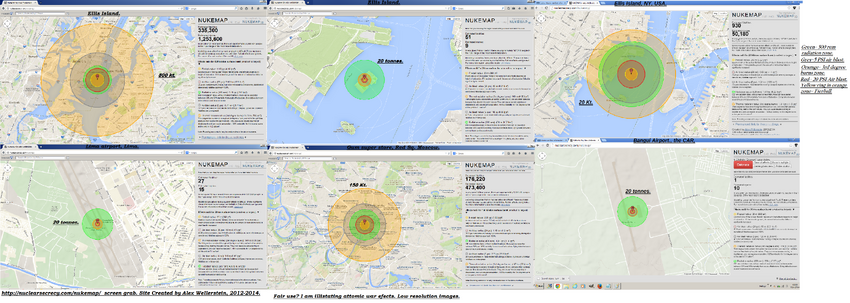
2014 Nuclear strike casualty predictions and radius according to Alex Wellerstine's Nuke Map siyte.
Outside of central Europe the Soviets' plans for Europe were to destroy military and industrial stuff, since they wanted to conquer, enslave and plunder (see the GDR). The USA was the only nation who went mostly after eastern European civvies in cities. US Brits, the French, China, S. Africa and the Israelis only wanted to do what was necessary to stay alive.
The DPRK, S. Korea and Cuba would be toast. San Julián Air Base and San Antonio de los Baños Airfield were not hit, but Havana and San Diego. A sea strike at Inishtrahull off the Donegal coast, since UK subs regularly loitered their. The American airbase at Aarbourg was targeted, but not Copenhagen as many thought.
Public and scholastic response
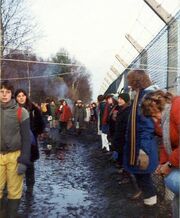
Greenham Common peace camp followers Embracing the base, event at Greenham Common AFB on December 1982.
CND
The Campaign for Nuclear Disarmament (CND) was founded in 1957 by Canon John Collins as a peace organisation that advocates avoiding nuclear war by the unilateral nuclear disarmament of the United Kingdom, eventual international nuclear disarmament and tighter international arms regulation along with restrictions on weapons testing through agreements such as the Nuclear Non-Proliferation Treaty. It is also opposed to any military action that may result in the use of any nuclear, chemical or biological weapons and the building of nuclear power stations in the UK.
The Doomsday Clock
Since 1947, the Doomsday Clock of the Bulletin of the Atomic Scientists visualises how far they think the world is from a nuclear war.
Popular culture
The threat of a nuclear holocaust plays an important role in the popular perception of nuclear weapons. It features in the security concept of mutually assured destruction (MAD) and is a common scenario in survivalism. Nuclear holocaust is a common feature in literature, online sites and film, especially in speculative genres such as science fiction, dystopian, doomsday and post-apocalyptic fiction.
Also see- these 3 wikis for an interesting alternate history stories about the event.
- http://althistory.wikia.com/wiki/Doomsday_%281983%3A_Doomsday%29
- http://alternate-future.wikia.com/wiki/1995_Armengeddon
- http://implausablealternatehistory.wikia.com/wiki/1962:_The_Apocalypse
The Helium Bomb (ヘリウム爆弾, Heriumu Bakudan) was a known nuclear weapon created (in this work of fiction) by the Garanda Empire.
The Meson bomb and related systems was a known nuclear weapon created (in these works of fiction) by TC, Metroid Prime and Metroid Prime 3
- http://www.hard-light.net/wiki/index.php/TC-Meson_Bomb
- http://metroid.wikia.com/wiki/Meson_Bomb_Launcher
Missile and anti-missile silo hunting
- Anti-ballistic missile system (ABM) deployed around Moscow to counter enemy ICBM targeting the city. In silos are probably Gazelle (SH-08) interceptor missiles. [1]
- Plattsburgh AFB Atlas Missile Site #07, 44.5472222, -73.975 [2]
- An anonymous Silo door, near Parshal, ND. 47.853609,-102.127275 [3]
- http://www.satellite-sightseer.com/id/8760
- https://www.google.com/maps/d/viewer?mid=zGJkktkfplh0.kmdzajaK_wOw&hl=en_US
- http://googlesightseeing.com/maps?p=&c=&t=h&hl=en&ll=47.853757,-102.127494&z=18
- http://virtualglobetrotting.com/category/buildings/military-missile-sites/
- http://www.npr.org/sections/thetwo-way/2014/07/31/336847318/to-find-america-s-nukes-try-google-maps
- https://productforums.google.com/forum/#!topic/gec-military-moderated/4iSsJARnk7M
Videos
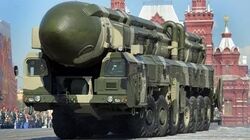
World War 3 Russia conducts surprise Large Scale Snap Nuclear Attack Drill (Oct 31, 2013)
World War 3: Russia conducts surprise Large Scale Snap Nuclear Attack Drill (Oct 31, 2013).

NUCLEAR-WAR---N-Korea-ARTILLERY-n-strategic-MISSILE-forces-on-ALERT-to-ATTACK-US-targets- WW3
NUCLEAR-WAR---N-Korea-ARTILLERY-n-strategic-MISSILE-forces-on-ALERT-to-ATTACK-US-targets-[WW3].

Soviet Union destroys North America (Nuclear War) - clip from the 1977 film
Soviet Union destroys North America (Nuclear War) - clip from the 1977 film.

Atomic Alert A Real Attack
The propaganda film "Atomic Alert: A Real Attack".

Atomic Attack (1950)
Atomic Attack (1950).

Nuclear Attack Strike On The U.K. Scenario (Not For The Squeamish)-0
Nuclear Attack Strike On The U.K. Scenario (Not For The Squeamish).
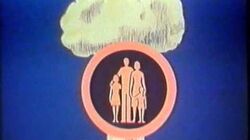
Protect & Survive - 1970's UK Public infommercials On Nuclear War Preparation
Protect & Survive - 1970's UK Public infommercials On Nuclear War Preparation.
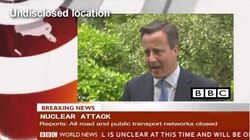
Nuke prank UK HD
Nuke prank UK HD by You Tube user The Volvic3 Project.

THERMONUCLEAR WARFARE U.S. Nuclear Retaliation Scenario (720p)
THERMONUCLEAR WARFARE: U.S. Nuclear Retaliation Scenario (720p).
Also see
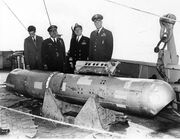
Eighty days after it fell into the ocean following the January 1966 mid-air collision between a nuclear-armed B-52G bomber and a KC-135 refuelling tanker over Palomares, Spain, this B28RI nuclear bomb was recovered from 2,850 feet (869 meters) of water and lifted aboard the USS Petrel (note the missing tail fins and badly dented "false nose"). This photograph was among the first ever published of a U.S. hydrogen bomb. Left to right are Sr. Don Antonio Velilla Manteca, chief of the Spanish Nuclear Energy Board in Palomares; Brigadier General Arturo Montel Touzet, Spanish coordinator for the search and recovery operation; Rear Admiral William S. Guest, commander of U.S. Navy Task Force 65; and Major General Delmar E. Wilson, commander of the Sixteenth Air Force.

Soviet Ivan Rogov-class landing ship.

PZL TS-11 Iskra (Spark) of Polish Air Force (registration number: 1406) on static display at Radom Air Show 2005.
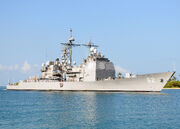
PEARL HARBOR (June 28, 2010) The Ticonderoga-class guided missile cruiser USS Chancellorsville (CG 62) arrives at Joint Base Pearl Harbor-Hickam to participate Rim of the Pacific (RIMPAC) 2010 exercises. RIMPAC is a biennial, multinational exercise designed to strengthen regional partnerships and improve multinational interoperability. (U.S. Navy photo by Mass Communication Specialist 2nd Class Jon Dasbach/Released).
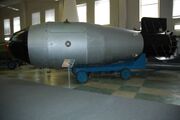
A replica of the Tsar bomb.

A B-61 nuke.
- Atomic videos
- Atomic demise (1979-1986)
- Atomic accidents and disasters
- Electromagnetic Pulse (EMP)
- RAF Menwith Hill
- Greenham Air Base
- KH-7 Gambit satellite
- Titan IIIB Rocket
- Kelvedon Hatch Secret Nuclear Bunker
- RAF Hack Green
- RAF Fylingdales
- Nuclear warfare
- Designated survivor
- A surprise nuclear attack
- Inner German Border
- Two-man rule
- World War Three: Inside the War Room (BBC Two war sim')
- RAF Fylingdales
- Permissive Action Link
- Emergency Action Message
- Special Weapons Emergency Separation System
- Seven days to the River Rhine (1979)
- Soviet invasion of Denmark
- Soviet/NATO invasion of Finland
- The 10 kiloton "Baneberry" weapons test error in Operation Emery
- RAF Upper Heyford
- Nukes
- Bombers
- Ballistic missiles, missiles and military rockets
- Bomb blast effects
- Explosive blast\yield
- RAF Fylingdales
- Atomic Weapons Establishment near Aldermaston
- The Republic of Mount Tarnica (implausablealternatehistory.wikia)
- Hack Green Secret Nuclear Bunker
- Kelvedon Hatch emergency broadcast tower
- Wartime Broadcasting Service (UK)
- Atomic Weapons Establishment near Aldermaston
- Nukes
- Nuclear warfare
- Designated survivor
- Two-man rule
- Permissive Action Link
- Emergency Action Message
- Special Weapons Emergency Separation System
- Nuclear Non-Proliferation Treaty
- DEFCON 1
- HANDEL
- CONELRAD
- Cuban Missile Crisis
- UGM-27 Polaris
- EMP
- Electromagnetic Pulse (EMP)
- Mushroom cloud
- Ike
- Korean War
- UK war time regional seats of government
- Chapelcross nuclear power station partial meltdown
- Nuclear briefcase
- Mount Yamantau
- Second Artillery Corps (PRC)
- National Command Authority (USA)
- CND
- Nuclear Non-Proliferation Treaty
- A surprise nuclear attack
- Operation Chrome Dome
- Atomic warfare information notes.
- Pre-emptive strike
- A surprise nuclear attack
- 1960 Bomarc Missile accident
- 1961 Goldsboro B-52 crash
- 1963 Test Ban Treaty
- 1966 Palomares B-52 crash
- 1968 Thule Air Base B-52 crash
- 1980 Titan II Missile Explosion
- 1983 Soviet nuclear false alarm incident
- Nuclear briefcase
- Nuclear football.
- Hack Green
- RAF Hack Green
- Hack Green Secret Nuclear Bunker
- Wartime Broadcasting Service
- Four-minute warning
- 1966 Palomares B-52 crash
- 1961 Goldsboro B-52 crash
- The 10 kiloton "Baneberry" weapons test error in Operation Emery
- Operation Chrome Dome
- Thule Air Base, Greenland
- Castle Bravo test blast miscalculation
- Bikini Atoll
- Nuclear fallout
- Woomera Test Range
- Operation Castle
- Operation Ivy
- Operation Able
- Operation Redwing
- Castle Romeo
- Operation Hardtack
- Ivy Mike
- MAD
- Tsar Bomba
- Enewetak Atoll
- Starfish Prime high-altitude nuclear test
- Errors I think hit DD83 on Althistory Wiki
- 1961 Yuba City B-52 crash
- 1964 Savage Mountain B-52 crash
- Americas' nuclear targets in 1959
- Duck and cover
- Hack Green Secret Nuclear Bunker
- Cuban Missile Chrisis
- The atomic artillery peace ‘Atomic Annie’
- 1960 Bomarc Missile accident
- Operation Chrome Dome
- B-52 Stratofortress bomber
- Johnston Atoll
- Korean War
- UK war time regional seats of government
- Nevada Test and Training Range
- Ike
- Nickel
- Bikini Atoll
- CND
- Titan II Missile
- DEFCON 1
- HANDEL
- CONELRAD
- Cuban Missile Crisis
- EMP
- Electromagnetic Pulse (EMP)
- Mushroom cloud
- Comprehensive Test Ban Treaty
- Germany's Fulda Gap
- The atomic artillery peace ‘Atomic Annie’
- 1960 Bomarc Missile accident
- Operation Chrome Dome
- B-52 Stratofortress bomber
- Johnston Atoll
- Woomara test range
- Atomic War
- Three Mile Island accident
- 1968 Thule Air Base B-52 crash
- 1963 Test Ban Treaty
- Atomic warfare information notes.
- Bikini Atoll
- CND
- USSR
- Exercise Able Archer '83
- DEFCON 1
- How to say "Polaris"
- Germany's Fulda Gap
- Exercise Reforger
- Exercise Dnepr 1967
- Nukes
- Davy Crockett Weapon System
- Communist old guard
- Greenham Air Base
- 1961 Goldsboro B-52 crash
- Tsar Bomba
- Exercise Reforger
- Exercise Able Archer '83
- Exercise Zapad-81
- Operation Chrome Dome
- Operation Square Leg (1980) and Exercise Hard Rock (1982)
- A surprise nuclear attack
- British Army of the Rhine (BAOR)
- River Elbe Line
- "Poland is 'toast'!"
- Missiles
- Kelvedon Hatch Secret Nuclear Bunker
- RAF Hack Green
- RAF Fylingdales
- Nuclear warfare
- Designated survivor
- A surprise nuclear attack
- Inner German Border
- Two-man rule
- World War Three: Inside the War Room (BBC Two war sim')
- RAF Fylingdales
- Permissive Action Link
- Emergency Action Message
- Special Weapons Emergency Separation System
- Seven days to the River Rhine (1979)
- Nuclear fallout
- A surprise nuclear attack
- Atomic accidents and disasters
- Atomic\nuclear power stations
- Mushroom cloud
- Atomic arsenals
- Bomb blast effects
- Atomic\nuclear war
- Atomic accidents and disasters
- The Campaign for Nuclear Disarmament (CND)
- Atomic War
- Atomic warfare information notes.
- A nuclear\atomic holocaust or nuclear apocalypse
- Nukes
- Explosive blast\yield
- Atomic arsenals
- Bomb blast effects
- Atomic\nuclear war
- Atomic accidents and disasters
- Atomic\nuclear power stations
- Geiger-Muller counter
- "Poland is 'toast'!"
- Nuclear fallout
- Atomic videos
Outside links and sources
- http://www.secretsofsurvival.com/survival/nuclear_war.html
- http://www.oism.org/nwss/s73p912.htm
- https://www.quora.com/Which-nations-would-most-likely-survive-a-full-out-nuclear-world-war
- https://jasonlefkowitz.net/2012/03/how-to-survive-an-atomic-bomb/
- http://europe.newsweek.com/how-survive-nuclear-war-331643?rm=eu
- http://www.dailymail.co.uk/sciencetech/article-2699854/Life-nuclear-war-revealed-Computer-models-reveal-Earth-suffer-20-year-long-winter-worldwide-famine.html
- http://www.dailymail.co.uk/sciencetech/article-2699854/Life-nuclear-war-revealed-Computer-models-reveal-Earth-suffer-20-year-long-winter-worldwide-famine.html
- http://www.johnstonsarchive.net/nuclear/nuclearwar1.html
- https://climate.nasa.gov/news/483/how-would-nuclear-war-affect-the-climate/
- http://www.dailymail.co.uk/sciencetech/article-2699854/Life-nuclear-war-revealed-Computer-models-reveal-Earth-suffer-20-year-long-winter-worldwide-famine.html
- http://www.dictionary.com/browse/shrapnel
- https://en.wikipedia.org/wiki/Shrapnel
- http://www.thefreedictionary.com/shrapnel
- https://www.merriam-webster.com/dictionary/shrapnel
- https://images.search.yahoo.com/search/images;_ylt=AwrBT813Zk5YRasAPYVXNyoA;_ylu=X3oDMTEyNGJsOGU5BGNvbG8DYmYxBHBvcwMxBHZ0aWQDQjMxMTNfMQRzZWMDc2M-?p=Shrapnel&fr=yset_chr_cnewtab
- http://discovermagazine.com/~/media/import/images/0/0/3/shrapnel.jpg?mw=900
- http://www.thomaswictor.com/wp-content/uploads/2014/10/shrapnel_wounds_Gaza_beach.jpg
- https://en.wikipedia.org/wiki/Shrapnel_shell
- http://www.lib.utexas.edu/maps/austria.html
- https://wyhs-human-geography.wikispaces.com/Europe
- http://maps.nationmaster.com/country/fi
- http://www.geocurrents.info/category/place/russia-ukraine-and-caucasus/siberia
- http://www.mapa-politico.com/europa/alemania-es.html?g2_page=5
- https://en.wikipedia.org/wiki/Krypton
- http://www.webelements.com/krypton/
- http://www.rsc.org/periodic-table/element/36/krypton
- http://education.jlab.org/itselemental/ele036.html
- http://www.radiologyinfo.org/en/info.cfm?pg=radioiodine
- https://en.wikipedia.org/wiki/Iodine-131
- https://en.wikipedia.org/wiki/Iodine
- https://en.wikipedia.org/wiki/Flash_blindness
- http://www.hf.faa.gov/docs/508/docs/cami/0107.pdf
- https://en.wikipedia.org/wiki/Photokeratitis
- http://www.atomicarchive.com/Effects/effects13.shtml
- http://www.buzzle.com/articles/causes-and-risks-of-flash-blindness.html
- Medical response to terrorism: preparedness and clinical practice. Author Daniel C.Keyes isbn = 978-0-7817-4986-2
- http://www.dictionary.com/browse/masthead
- http://www.ki4u.com/nuclearsurvival/states/ky.htm
- http://www.pbs.org/wgbh/americanexperience/bomb/sfeature/mapablast.html
- http://clearlyexplained.com/chemical-elements/caesium/index.html
- http://www.livinghistoryfarm.org/farminginthe50s/life_06.html
- http://www.ft.com/cms/s/0/424b780e-e9c5-11e5-bb79-2303682345c8.html
- http://uk.reuters.com/article/global-metals-idUKL3N16M2XM
- http://www.chemicool.com/elements/plutonium.html
- http://www.bikebiz.com/news/read/felloe-launches-aluminium-rim-hub-spoke-production-services/019247
- https://en.wikipedia.org/wiki/Bomb
- https://en.wikipedia.org/wiki/Oklahoma_City_bombing
- https://www.physicsforums.com/threads/what-would-the-explosive-yield-be.184435/
- http://www.unitconversion.org/energy/joules-to-megatons-conversion.html
- https://www.physicsforums.com/threads/calculating-the-explosive-yield-of-an-atomic-bomb.456839/
- https://en.wikipedia.org/wiki/Polymer-bonded_explosive
- https://www.conversion-metric.org/weight/gram-to-ounce
- http://www.innovateus.net/science/what-are-different-types-explosives
- http://www.tnt-explosives.com/ammonite-6-zhv/
- https://books.google.co.uk/books?id=hNcZJ35dIyUC&pg=PR180&redir_esc=y#v=onepage&q&f=false
- https://en.wikipedia.org/wiki/Relative_effectiveness_factor
- https://en.wikipedia.org/wiki/Dynamite#Difference_from_TNT
- https://en.wikipedia.org/wiki/Trinitrotoluene#Explosive_character
- https://answers.yahoo.com/question/index;_ylt=A0LEV1ti50JYw5gARjVXNyoA;_ylu=X3oDMTEybWZhYzBnBGNvbG8DYmYxBHBvcwMyBHZ0aWQDQjMxMzRfMQRzZWMDc3I-?qid=20081126012757AAQZ1Fv&p=how%20powerfull%20is%20torvex%20compaired%20to%20TNT
- https://en.wikipedia.org/wiki/Dynamite
- https://en.wikipedia.org/wiki/Nuclear_weapon_yield
- http://www.stardestroyer.net/Resources/Calculators/NuclearExplosions.html
- http://www.st-v-sw.net/Obsidian/Martin/photontorpedo.htm
- http://www.edwardmuller.com/index.php?Page=calculator
- https://en.wikipedia.org/wiki/TNT_equivalent
- http://meyerweb.com/eric/tools/gmap/hydesim.html
- http://www.unitconversion.org/energy/tons-explosives-to-gigajoules-conversion.html
- http://www.webmd.com/heart-disease/tc/using-nitroglycerin-for-sudden-chest-pain-topic-overview#1
- http://www.tnt-explosives.com/rpe-zarya-ltd/
- https://en.wikipedia.org/wiki/GBU-43/B_Massive_Ordnance_Air_Blast
- https://en.wikipedia.org/wiki/RP-3
- https://en.wikipedia.org/wiki/F1_grenade_(Russia)
- https://en.wikipedia.org/wiki/Tallboy_(bomb)
- https://en.wikipedia.org/wiki/ASM-A-1_Tarzon
- https://en.wikipedia.org/wiki/Grand_Slam_(bomb)
- https://en.wikipedia.org/wiki/Fritz_X
- https://www.revolvy.com/main/index.php?s=Grenade
- http://encyclopedia2.thefreedictionary.com/EC+smokeless+powder
- https://en.wikipedia.org/wiki/W48
- http://encyclopedia2.thefreedictionary.com/EC+smokeless+powder
- https://en.wikipedia.org/wiki/Picric_acid
- https://en.wikipedia.org/wiki/UGM-27_Polaris
- https://en.wikipedia.org/wiki/W48
- https://en.wikipedia.org/wiki/Operation_Buster%E2%80%93Jangle
- https://en.wikipedia.org/wiki/History_of_nuclear_weapons
- https://en.wikipedia.org/wiki/Ivy_Mike
- http://nuclearweaponarchive.org/Usa/Tests/Busterj.html
- https://en.wikipedia.org/wiki/Little_Boy
- https://en.wikipedia.org/wiki/Fat_Man
- https://www.steeldoor.org/blastdoors.php
- http://americanblastdoor.com/blast-door-single-leaf.html
- https://en.wikipedia.org/wiki/Blast_shelter
- https://en.wikipedia.org/wiki/Gelignite
- https://en.wikipedia.org/wiki/Relative_effectiveness_factor
- https://en.wikipedia.org/wiki/Dynamite#Difference_from_TNT
- https://en.wikipedia.org/wiki/Trinitrotoluene#Explosive_character
- https://answers.yahoo.com/question/index;_ylt=A0LEV1ti50JYw5gARjVXNyoA;_ylu=X3oDMTEybWZhYzBnBGNvbG8DYmYxBHBvcwMyBHZ0aWQDQjMxMzRfMQRzZWMDc3I-?qid=20081126012757AAQZ1Fv&p=how%20powerfull%20is%20torvex%20compaired%20to%20TNT
- http://www.nuclearweaponarchive.org/Nwfaq/Nfaq4-1.html#Nfaq4.1.6.2
- http://dspace.dsto.defence.gov.au/dspace/bitstream/1947/3621/1/DSTO-TN-0049%20PR.pdf
- http://www.everydayhealth.com/drugs/nitroglycerin
- https://medlineplus.gov/druginfo/meds/a601086.html
- http://www.webmd.com/drugs/2/drug-18030/nitroglycerin-oral/details
- https://en.wikipedia.org/wiki/Nitroglycerin
- http://search.ebscohost.com/login.aspx?direct=true&db=hxh&AN=9703191987&site=src-live
- http://www.dailymail.co.uk/health/article-1253032/How-dynamite-help-destroy-prostate-cancer.html
- https://en.wikipedia.org/wiki/Gunpowder
- https://en.wikipedia.org/wiki/Polymer-bonded_explosive
- https://en.wikipedia.org/wiki/Trauzl_lead_block_test
- https://www.drugs.com/cdi/nitroglycerin.html
- http://www.webmd.com/drugs/2/drug-18030/nitroglycerin-oral/details
- https://medlineplus.gov/druginfo/meds/a601086.html
- http://chemistry.about.com/od/historyofchemistry/a/gunpowder.htm
- http://www3.nd.edu/~aiaa/usli/documents/BP%20MSDS.pdf
- https://en.wikipedia.org/wiki/Gunpowder
- https://images.search.yahoo.com/search/images;_ylt=A0LEV054.EFY.B4Av.5XNyoA;_ylu=X3oDMTEyMjBhazUwBGNvbG8DYmYxBHBvcwMxBHZ0aWQDQjMxMzRfMQRzZWMDc2M-?p=Torpex+Explosive&fr=yset_chr_cnewtab
- https://en.wikipedia.org/wiki/Relative_effectiveness_factor
- https://en.wikipedia.org/wiki/Dynamite#Difference_from_TNT
- https://en.wikipedia.org/wiki/Trinitrotoluene#Explosive_character
- https://answers.yahoo.com/question/index;_ylt=A0LEV1ti50JYw5gARjVXNyoA;_ylu=X3oDMTEybWZhYzBnBGNvbG8DYmYxBHBvcwMyBHZ0aWQDQjMxMzRfMQRzZWMDc3I-?qid=20081126012757AAQZ1Fv&p=how%20powerfull%20is%20torvex%20compaired%20to%20TNT
- https://en.wikipedia.org/wiki/Gunpowder
- http://www.world-aluminium.org/
- http://www.lme.com/metals/non-ferrous/aluminium/
- http://www.chemicool.com/elements/thorium.html
- http://www.chemicool.com/elements/aluminum.html
- http://www.chemicool.com/elements/iodine.html
- http://www.bidvestcateringequipment.com/Product/Aluminium-Omelette-Pan/256
- http://images-of-elements.com/
- http://www.tracesciences.com/fe.htm
- http://www.webelements.com/iron/isotopes.html
- http://education.jlab.org/itselemental/iso026.html
- https://en.wikipedia.org/wiki/Iron
- http://www.foxnews.com/us/2016/03/11/waters-around-florida-nuclear-plant-shows-increased-levels-tritium.html
- https://en.wikipedia.org/wiki/Tritium_illumination
- https://en.wikipedia.org/wiki/Table_of_nuclides_(complete)
- https://en.wikipedia.org/wiki/Tritium
- http://www.dailymail.co.uk/news/article-2018121/Teen-burned-alive-mothers-jealous-boyfriend-St-Pauls-Minnesota-speaks.html
- http://community.wikia.com/wiki/User_blog:Mira_Laime/How_to_Deal_With_a_Bad_Bureaucrat
- http://www.physics.isu.edu/radinf/tritium.htm
- https://en.wikipedia.org/wiki/Hydrogen
- https://ro.wikipedia.org/wiki/Hidrogen
- https://id.wikipedia.org/wiki/Hidrogen
- https://en.wiktionary.org/wiki/hidrogen
- https://en.wikipedia.org/wiki/Hydrogen
- https://en.wikipedia.org/wiki/Tritium
- https://www.epa.gov/radiation#inthebody
- http://www.nrc.gov/reactors/operating/ops-experience/tritium/faqs.html#normal
- http://www.nbcnews.com/id/43475479/ns/us_news-environment/
- http://www.chemicool.com/elements/hydrogen.html
- http://www.dailymail.co.uk/news/article-2018121/Teen-burned-alive-mothers-jealous-boyfriend-St-Pauls-Minnesota-speaks.html
- http://community.wikia.com/wiki/User_blog:Mira_Laime/How_to_Deal_With_a_Bad_Bureaucrat
- http://www.chemicool.com/elements/krypton.html
- https://www.urmc.rochester.edu/Encyclopedia/Content.aspx?ContentTypeID=90&ContentID=P09575
- https://www.urmc.rochester.edu/Encyclopedia/Content.aspx?ContentTypeID=90&ContentID=P01738
- http://www.stanfordchildrens.org/en/topic/default?id=classification-and-treatment-of-burns-90-P01738
- https://en.wikipedia.org/wiki/Isotopes_of_strontium#Strontium-91
- http://www.webmd.com/vitamins-supplements/ingredientmono-1077-strontium.aspx?activeingredientid=1077&
- https://fr.wikipedia.org/wiki/Isotopes_du_zirconium
- https://en.wikipedia.org/wiki/Isotopes_of_zirconium
- http://www.webelements.com/zirconium/isotopes.html
- http://www.ncbi.nlm.nih.gov/books/NBK215133/
- https://en.wikipedia.org/wiki/Isotopes_of_molybdenum
- https://www.iaea.org/About/Policy/GC/GC54/GC54InfDocuments/English/gc54inf-3-att7_en.pdf
- http://www2.mallinckrodt.com/nuclear_imaging/Global_Mo-99_Supply_Chain.aspx
- http://www.ncbi.nlm.nih.gov/books/NBK215133/
- http://www.world-nuclear-news.org/V-The-realities-of-Mo-99-production-27051502.html
- https://en.wikipedia.org/wiki/Isotopes_of_ruthenium
- http://www.bebig.com/international/products/ophthalmic-brachytherapy/ru-106-eye-applicators.html
- http://www.ncbi.nlm.nih.gov/pubmed/22042011
- http://www.nucleide.org/DDEP_WG/Nuclides/Ru-106_tables.pdf
- http://www.ezag.com/home/products/radiation-therapy/ophthalmic-brachytherapy/ru-106-eye-applicators.html
- http://periodictable.com/Isotopes/051.131/index2.html
- https://books.google.co.uk/books?id=zWPVCgAAQBAJ&pg=PA226&lpg=PA226&dq=Sb+131+isotope&source=bl&ots=dlMBWVLsF3&sig=d_pJzP2EPe54H5BwfDCf8aDOoKc&hl=en&sa=X&ved=0ahUKEwj-yJ6bk7LLAhWCcRQKHdyFD8sQ6AEIKzAD#v=onepage&q=Sb%20131%20isotope&f=false
- http://link.springer.com/chapter/10.1007%2F978-3-540-75278-3_411#page-1
- http://periodictable.com/Isotopes/051.131/index2.html
- http://www.telegraph.co.uk/news/health/news/11458731/UK-medical-first-as-girl-with-huge-birthmark-undergoes-pioneering-balloon-treatment-to-grow-new-skin.html
- https://en.wikipedia.org/wiki/Isotopes_of_antimony
- http://www.walkermorgan.com/fourth-fifth-sixth-degrees
- https://en.wikipedia.org/wiki/Burn
- http://kfor.com/2014/06/24/local-teenager-slowly-recovering-from-unheard-of-5th-6th-degree-burns/
- http://kfor.com/2014/02/12/prague-teenager-attempting-to-recover-from-5th-and-6th-degree-burns/
- http://www.doccs.us/burns/
- https://en.wikipedia.org/wiki/Aerosol_burn
- http://www.nbcnews.com/404/
- http://burn-osx.sourceforge.net/Pages/English/home.html
- http://burn-osx.sourceforge.net/Pages/English/home.html
- http://www.webmd.com/pain-management/guide/pain-caused-by-burns
- http://www.healthline.com/health/burns#Complications6
- http://www.who.int/violence_injury_prevention/child/injury/world_report/Burns_english.pdf
- https://en.wikipedia.org/wiki/Burn
- http://hospitals.unm.edu/burn/classification.shtml
- https://www.nlm.nih.gov/medlineplus/ency/article/003074.htm
- https://en.wikipedia.org/wiki/Stridor
- https://books.google.com/books?id=rF1WTiX0nHEC&pg=PA485
- https://books.google.com/books?id=PyUSgdZUGr4C&pg=PA205
- https://en.wikipedia.org/wiki/Burn#Thermal
- http://www.theguardian.com/world/2016/mar/01/french-riot-police-teargas-jungle-calais-camp-evictions
- http://www.popsugar.co.uk/beauty/Burn-Survivor-Makeup-Transformations-40393416#photo-40393416
- http://www.popsugar.co.uk/beauty/Burn-Survivor-Makeup-Transformations-40393416#photo-interstitial-0
- https://www.nlm.nih.gov/medlineplus/ency/article/000030.htm
- http://burnbrightlove.com/why-lady-gagas-performance-was-the-most-important-part-of-the-oscars/
- http://www.atsdr.cdc.gov/toxprofiles/tp147.pdf
- http://www.atsdr.cdc.gov/substances/toxsubstance.asp?toxid=121
- http://energyfromthorium.com/2006/07/09/health-and-safety-aspects-of-thorium-production/
- https://en.wikipedia.org/wiki/Atomic_bombings_of_Hiroshima_and_Nagasaki
- http://www.express.co.uk/news/science/646749/FRONT-room-sized-meteor-came-out-of-nowhere-and-exploded-with-force-of-Hiroshima-bomb
- http://www.history.com/topics/world-war-ii/bombing-of-hiroshima-and-nagasaki
- http://www.dailymail.co.uk/news/article-3186815/The-nightmare-aftermath-Hiroshima-Parents-carry-burned-children-past-corpses-rubble-rare-photographs-taken-days-atomic-bomb-killed-140-000-people.html
- https://en.wikipedia.org/wiki/Acute_radiation_syndrome
- https://www.nlm.nih.gov/medlineplus/ency/article/000026.htm
- https://www.nlm.nih.gov/medlineplus/ency/article/000026.htm
- http://www.mayoclinic.org/diseases-conditions/radiation-sickness/basics/definition/con-20022901
- https://en.wikipedia.org/wiki/Therac-25
- https://en.wikipedia.org/wiki/Poisoning_of_Alexander_Litvinenko
- https://en.wikipedia.org/wiki/Leukopenia
- https://en.wikipedia.org/wiki/Collimator
- https://en.wikipedia.org/wiki/1996_San_Juan_de_Dios_radiotherapy_accident
- https://en.wikipedia.org/wiki/Telstar
- http://roland.lerc.nasa.gov/~dglover/sat/telstar.html
- https://en.wikipedia.org/wiki/Atomic_bombings_of_Hiroshima_and_Nagasaki
- https://en.wikipedia.org/wiki/Nuclear_weapon
- http://www.britannica.com/technology/atomic-bomb
- http://www.history.com/topics/world-war-ii/bombing-of-hiroshima-and-nagasaki
- http://www.express.co.uk/news/science/646749/FRONT-room-sized-meteor-came-out-of-nowhere-and-exploded-with-force-of-Hiroshima-bomb
- http://www.slate.com/articles/technology/future_tense/2015/07/emp_threats_could_an_electro_magnetic_pulse_weapon_wipe_out_the_power_grid.html
- https://en.wikipedia.org/wiki/Electromagnetic_pulse
- http://www.digitaltrends.com/cool-tech/us-air-force-confirms-boeings-electromagnetic-pulse-weapon/
- https://en.wikipedia.org/wiki/Atomic_bombings_of_Hiroshima_and_Nagasaki
- http://www.futurescience.com/emp/emp-myths.html
- http://edition.cnn.com/videos/us/2015/05/25/orig-boeing-electromagnetic-pulse-weapon.cnn
- http://www.slate.com/articles/technology/future_tense/2015/07/emp_threats_could_an_electro_magnetic_pulse_weapon_wipe_out_the_power_grid.html
- http://picks.slate.com/products/thermapen-mk4
- http://www.slate.com/blogs/the_slatest/2016/02/09/supreme_court_deals_blow_to_obama_plan_to_curb_carbon_emissions_from_coal.html
- https://www.vice.com/en_uk/read/we-asked-a-military-expert-how-scared-the-us-should-be-of-an-emp-attack-508
- https://en.wikipedia.org/wiki/Intermediate-range_ballistic_missile
- http://missilethreat.com/missile-class/intermediate-range-ballistic-missile-irbm/
- http://www.discovery.com/tv-shows/other-shows/videos/future-weapons-emp-bomb/
- http://www.nuclearblast.de/en/label/music/band/shop/70967.anthrax.html?gclid=CKCF5PiO_coCFeISwwodE14I-g
- https://en.wikipedia.org/wiki/Intercontinental_ballistic_missile
- https://en.wikipedia.org/wiki/List_of_ICBMs
- https://en.wikipedia.org/wiki/Intercontinental_ballistic_missile
- https://en.wikipedia.org/wiki/List_of_missiles
- http://www.idsa.in/idsacomments/north-korea-launching-a-satellite-to-demonstrate-icbm-capability_avlele_180216
- http://foreignpolicy.com/2016/02/19/are-you-scared-about-north-koreas-thermonuclear-icbm/
- https://en.wikipedia.org/wiki/Intercontinental_ballistic_missile
- http://science.howstuffworks.com/e-bomb3.htm
- http://www.bbc.co.uk/news/business-12110141
- http://www.nrc.gov/reading-rm/doc-collections/fact-sheets/plutonium.html
- http://world-nuclear.org/information-library/nuclear-fuel-cycle/fuel-recycling/plutonium.aspx
- http://www.lenntech.com/periodic/elements/pu.htm
- http://education.jlab.org/itselemental/ele094.html
- http://ieer.org/resource/factsheets/plutonium-factsheet/
- http://www.scientificamerican.com/article/within-nasa-a-plutonium-power-struggle/
- http://www.chemicool.com/elements/strontium.html
- http://www.nucleardarkness.org/warconsequences/hundredfiftytonessmoke/
- http://www.survivalring.org/community/library/us-nuclear-targets/
- http://www.nrdc.org/nuclear/nwarplan.asp
- http://www.nrdc.org/nuclear/warplan/index.asp
- http://estonianworld.com/security/target-estonia-britains-nuclear-plan-for-tallinn-tartu-and-viljandi/
- http://education.jlab.org/itselemental/ele038.html
- http://www.webmd.com/vitamins-supplements/ingredientmono-1077-strontium.aspx?activeingredientid=1077&activeingredientname=strontium
- http://www.webmd.boots.com/osteoporosis/guide/osteoporosis
- http://www.webelements.com/strontium/
- http://www.rsc.org/periodic-table/element/38/strontium
- http://www.livescience.com/34522-strontium.html
- http://www.lenntech.com/periodic/elements/sr.htm
- http://www.chemicool.com/elements/strontium.html
- http://www.fin24.com/Companies/Mining/uranium-in-karoo-may-be-10-fold-more-than-thought-20160215
- https://books.google.co.uk/books?id=affpAgAAQBAJ&pg=PA245&lpg=PA245&dq=uranium+london+metal+exchange&source=bl&ots=zEHQaid_wB&sig=tdWQNE6ERQr1nG-ba1xnk1ov-S8&hl=en&sa=X&ved=0ahUKEwi_99CKmfvKAhWFThQKHdnEA4QQ6AEIVDAI#v=onepage&q=uranium%20london%20metal%20exchange&f=false
- http://www.marketwatch.com/story/uranium-poised-to-rebound-post-fukushima-2015-09-18
- http://www.infomine.com/investment/
- http://www.chemicalelements.com/elements/cs.html
- http://www.webelements.com/caesium/
- http://www.rsc.org/periodic-table/element/55/caesium
- https://www.cs.rochester.edu/~nelson/cesium/cesium_faq.html
- https://books.google.co.uk/books?id=affpAgAAQBAJ&pg=PA245&lpg=PA245&dq=uranium+london+metal+exchange&source=bl&ots=zEHQaid_wB&sig=tdWQNE6ERQr1nG-ba1xnk1ov-S8&hl=en&sa=X&ved=0ahUKEwi_99CKmfvKAhWFThQKHdnEA4QQ6AEIVDAI#v=onepage&q=uranium%20london%20metal%20exchange&f=false
- http://www.lenntech.com/periodic/elements/cs.htm
- http://education.jlab.org/itselemental/ele055.html
- http://www.plymouthherald.co.uk/Green-campaigners-alarmed-rising-levels-plutonium/story-28738990-detail/story.html
- http://www.bbc.co.uk/news/business-12110141
- http://world-nuclear.org/information-library/nuclear-fuel-cycle/fuel-recycling/plutonium.aspx
- http://www.lenntech.com/periodic/elements/pu.htm
- https://armscontrolnow.org/2012/08/03/hiroshima-and-nagasaki-never-again/
- http://edition.cnn.com/2015/12/23/politics/cold-war-u-s-nuclear-target-list/
- https://en.wikipedia.org/wiki/Single_Integrated_Operational_Plan
- http://www.globalresearch.ca/u-s-cold-war-nuclear-attack-target-list-of-1200-soviet-bloc-cities-from-east-germany-to-china-declassified/5497970
- http://www.nrdc.org/nuclear/planphoto/planphoto12.asp
- http://www.nrdc.org/nuclear/planphoto/planphoto11.asp
- http://carolmoore.net/nuclearwar/progression.html
- http://www.dailymail.co.uk/news/article-2256003/U-S-New-Zealand-secretly-tested-tsunami-bombs-designed-trigger-tidal-waves-destroy-coastal-cities.html
- https://en.wikipedia.org/wiki/Tsunami_bomb
- https://www.quora.com/Could-detonating-a-nuclear-bomb-on-the-seabed-cause-a-devastating-tsunami
- https://uk.answers.yahoo.com/question/index?qid=20060724142909AAg5F8h
- http://ieer.org/resource/factsheets/uranium-its-uses-and-hazards/
- https://en.wikipedia.org/wiki/Uranium-235
- http://hyperphysics.phy-astr.gsu.edu/hbase/nucene/u235chn.html
- http://hyperphysics.phy-astr.gsu.edu/hbase/nucene/fission.html
- http://www.britannica.com/science/uranium-235
- http://www.robedwards.com/2014/06/revealed-the-106-cold-war-nuclear-targets-across-the-uk.html
- http://hyperphysics.phy-astr.gsu.edu/hbase/nucene/fission.html
- http://hyperphysics.phy-astr.gsu.edu/hbase/nucene/fission.html
- http://www.lme.com/metals/minor-metals/cobalt/
- https://en.wikipedia.org/wiki/Cobalt
- http://www.hlchina.com/gmastatement.html
- https://www.reddit.com/r/AskScienceDiscussion/comments/1iddov/is_it_be_feasible_or_even_possible_to_build_a/
- https://www.amnesty.org/en/latest/news/2016/01/Child-labour-behind-smart-phone-and-electric-car-batteries/
- http://www.theguardian.com/global-development/2016/jan/19/children-as-young-as-seven-mining-cobalt-for-use-in-smartphones-says-amnesty
- https://en.wikipedia.org/wiki/Meson_bomb
- http://www.thenakedscientists.com/forum/index.php?topic=14673.0
- https://en.wikipedia.org/wiki/Triple-alpha_process
- http://www.vox.com/science-and-health/2016/1/6/10723918/whats-a-hydrogen-bomb
- https://uk.answers.yahoo.com/question/index?qid=1006031414394
- http://www.britannica.com/technology/thermonuclear-bomb
- http://nextbigfuture.com/2015/01/helium-3-from-moon-would-make-better.html
- http://books.google.com/books?id=7s0NGIfflOgC&pg=PA332
- http://books.google.com/books?id=_fC7lAg5ZU0C&pg=PA132
- http://books.google.com/books?id=asmyUHd3_oQC&pg=PA134
- The Nuclear Express: A Political History of the Bomb and Its Proliferation, By Thomas C. Reed, Danny B. Stillman (2010), page 181 A number of analysts believe that the Vela incident was an Israeli neutron bomb experiment.
- The Nuclear Express: A Political History of the Bomb and Its Proliferation, By Thomas C. Reed, Danny B. Stillman (2010), page 177
- Asimov, Isaac. The New Intelligent Man's Guide to Science. Basic Books, New York, 1965. Page 410.
- http://www.wikiwand.com/en/Daigo_Fukury%C5%AB_Maru
- https://en.wikipedia.org/wiki/Nuclear_fallout
- http://www.chemicool.com/elements/nickel.html
- http://www.chemicool.com/elements/uranium.html
- http://www.medicalnewstoday.com/articles/58088.php
- http://education.jlab.org/itselemental/ele084.html
- https://en.wikipedia.org/wiki/Poisoning_of_Alexander_Litvinenko
- https://en.wikipedia.org/wiki/Polonium
- https://en.wikipedia.org/wiki/Poisoning_of_Alexander_Litvinenko
- http://www.bbc.co.uk/news/health-33717184
- https://en.wikipedia.org/wiki/Nuclear_fallout
- http://www.telegraph.co.uk/news/uknews/law-and-order/12111319/Litvinenko-Inquiry-What-is-Polonium-210.html
- http://www.nuclearfiles.org/menu/key-issues/nuclear-weapons/basics/neutron-bomb.htm
- http://www.britannica.com/technology/neutron-bomb
- http://www.nuclearfiles.org/menu/key-issues/nuclear-weapons/basics/neutron-bomb.htm
- https://en.wikipedia.org/wiki/Plutonium
- http://www.livescience.com/39871-facts-about-plutonium.html
- http://www.bbc.co.uk/news/world-asia-35534995
- http://www.reuters.com/article/us-northkorea-nuclear-usa-plutonium-idUSKCN0VI1WV
- http://edition.cnn.com/2016/02/10/asia/north-korea-weapons/
- http://www.world-nuclear.org/information-library/nuclear-fuel-cycle/fuel-recycling/plutonium.aspx
- http://education.jlab.org/itselemental/ele055.html
- https://en.wikipedia.org/wiki/Caesium
- https://cesiumjs.org/
- http://www.lenntech.com/periodic/elements/cs.htm
- https://en.wikipedia.org/wiki/Caesium
- https://cesiumjs.org/
- https://cesium.agi.com/
- http://www.chemicool.com/elements/cesium.html
- http://www.chemicool.com/elements/polonium.html
- http://www.chemicool.com/elements/plutonium.html
- http://www.chemicool.com/elements/uranium.html
- http://www.chemicool.com/elements/cobalt.html
- http://www.thefreedictionary.com/holocaust
- https://en.wikipedia.org/wiki/Dirty_bomb
- http://www.wikiwand.com/en/Haze
- https://en.wikipedia.org/wiki/Nuclear_winter
- https://en.wikipedia.org/w/index.php?title=Nuclear_darkness&redirect=no
- http://www.agu.org/meetings/fm06/fm06-sessions/fm06_U14A.html
- http://www.eoearth.org/article/Nuclear_winter
- http://www.atomicarchive.com/Movies/Movie6.shtml
- http://climate.envsci.rutgers.edu/nuclear
- http://envsci.rutgers.edu/~robock
- http://climate.envsci.rutgers.edu/nuclear/
- http://babel.hathitrust.org/cgi/pt?id=uc1.31822020694212;view=1up;seq=11
- http://www.eoearth.org/article/Nuclear_winter The Encyclopedia of Earth, Nuclear Winter
- http://althistory.wikia.com/wiki/Climate_%281983:_Doomsday%29
- http://www3.wooster.edu/history/jgates/book-h11.html
- http://acd.ucar.edu/~mmills/pdf/2008MillsPNAS_MassiveOzoneLoss.pdf
- http://www.sciencedaily.com/releases/2006/12/061211090729.htm
- http://climate.envsci.rutgers.edu/nuclear/
- https://en.wikipedia.org/wiki/Nuclear_winter#Consequences
- http://www.infoplease.com/encyclopedia/history/hydrogen-bomb.html
- https://en.wikipedia.org/wiki/Thermonuclear_weapon
- http://news.sky.com/story/1635065/japan-threatens-to-shoot-down-north-korea-rocket
- http://www.slate.com/articles/life/the_spectator/2007/08/the_return_of_the_doomsday_machine.html
- https://books.google.co.uk/books?id=0v0dAwAAQBAJ&pg=PA407&lpg=PA407&dq=doomsday+bomb+slate&source=bl&ots=9Xyj3GgnLF&sig=hBiDKjOs3CNaBw7UvodRCwPr5fg&hl=en&sa=X&ved=0ahUKEwjut-zAj93KAhXJthQKHaxDAmgQ6AEILzAD#v=onepage&q=doomsday%20bomb%20slate&f=false
- http://jalopnik.com/the-flying-crowbar-the-insane-doomsday-weapon-america-1435286216
- http://www.rense.com/general40/dooms.htm
- http://www.atomicarchive.com/Movies/Movie6.shtml Nuclear Winter Simulation Animation
- http://climate.envsci.rutgers.edu/nuclear/ New studies of climatic consequences of regional nuclear conflict
- http://www.eoearth.org/article/Nuclear_winter The Encyclopedia of Earth, Nuclear Winter
- http://www.atomicarchive.com/Movies/Movie6.shtml Nuclear Winter Simulation Animation
- http://climate.envsci.rutgers.edu/nuclear/ New studies of climatic consequences of regional nuclear conflict
- http://envsci.rutgers.edu/~robock Alan Robock ,
- http://jalopnik.com/the-flying-crowbar-the-insane-doomsday-weapon-america-1435286216
- http://www.rense.com/general40/dooms.htm
- https://web.archive.org/20141006085234/
- http://www.agu.org/meetings/fm06/fm06-sessions/fm06_U14A.html
- http://climate.envsci.rutgers.edu/pdf/RobockNW2006JD008235.pdf
- http://climate.envsci.rutgers.edu/nuclear/
- https://en.wikipedia.org/wiki/Solar_irradiance
- https://en.wikipedia.org/wiki/Doomsday_device
- http://www.wired.com/2007/09/soviet-doomsday/
- http://www.slate.com/articles/life/the_spectator/2007/08the_return_of_the_doomsday_machine.html.
- http://www.nuclearfiles.org/menu/key-issues/nuclear-weapons/basics/neutron-bomb.htm
- http://www.britannica.com/technology/neutron-bomb
- http://www.nuclearfiles.org/menu/key-issues/nuclear-weapons/basics/neutron-bomb.htm
- http://books.google.com/?id=JelgwgVx-P0C&pg=PA75&dq=%22leo+szilard%22+salted+cobalt+nuclear+life&cd=1#v=onepage&q=&f=false
- http://nuclearweaponarchive.org/
- Samuel Glasstone, The Effects of Nuclear Weapons, 1962, Revised 1964, U.S. Dept of Defense and U.S. Dept of Energy, pp.464–5. This section was removed from later editions, but, according to Glasstone in 1978, not because it was inaccurate or because the weapons had changed.
- https://en.wikipedia.org/wiki/Radiation_damage
- https://en.wikipedia.org/wiki/Ionizing_radiation
- http://www.who.int/ionizing_radiation/about/what_is_ir/en/
- ICRP publication 103 paragraph 55
- http://en.wikipedia.org/wiki/High-altitude_nuclear_explosion
- http://en.wikipedia.org/wiki/Electromagnetic_pulse
- http://en.wikipedia.org/wiki/Nuclear_electromagnetic_pulse
- http://en.wikipedia.org/wiki/Starfish_Prime
- http://www.belfasttelegraph.co.uk/sunday-life/nuclear-war-the-hidden-threat-to-northern-ireland-28497656.html
- https://fas.org/news/russia/1994/jptnd019_94033.htm
- http://www.livescience.com/33348-antimatter-destroy-world.html
- https://en.wikipedia.org/wiki/Antimatter_weapon
- Dockery, Kevin. Weapons of the Navy SEALs, Berkley Publishing Group, New York (2004). p. 237.
- http://www.sfgate.com/science/article/Air-Force-pursuing-antimatter-weapons-Program-2689674.php
- http://ccablog.blogspot.co.uk/2006_02_01_archive.html
- https://www.quora.com/Where-would-I-be-safest-in-a-nuclear-war-Canada-or-the-United-States-of-America
- http://www.rense.com/general74/EDS.HTM
- http://gizmodo.com/5859039/check-if-your-house-will-be-vaporized-in-a-nuclear-war
- http://www.livescience.com/39773-facts-about-uranium.html
- https://en.wikipedia.org/wiki/Uranium
- http://world-nuclear.org/information-library/nuclear-fuel-cycle/introduction/what-is-uranium-how-does-it-work.aspx
- http://www.foxnews.com/politics/2016/02/12/top-official-overseeing-nuclear-deal-unsure-where-irans-enriched-uranium-is-stored.html
- http://www.upi.com/Top_News/World-News/2016/02/12/North-Korea-turning-toward-uranium-enrichment-Tokyo-says/2321455334494/
- http://nextbigfuture.com/2016/02/uranium-and-nuclear-energy.html
- http://nextbigfuture.com/2016/02/uranium-and-nuclear-energy.html
- https://en.wikipedia.org/wiki/Nuclear_weapon
- http://www.hlchina.com/gmastatement.html
- http://edition.cnn.com/2015/12/23/politics/cold-war-u-s-nuclear-target-list/
- http://nsarchive.gwu.edu/nukevault/ebb538-Cold-War-Nuclear-Target-List-Declassified-First-Ever/
- http://coldwardecoded.blogspot.co.uk/2013/07/nuclear-war-in-west-seven-days-to-river.html
- https://www.reddit.com/r/AskScienceDiscussion/comments/1iddov/is_it_be_feasible_or_even_possible_to_build_a/
- http://www.thenakedscientists.com/forum/index.php?topic=14673.0
- https://en.wikipedia.org/wiki/Triple-alpha_process
- http://www.vox.com/science-and-health/2016/1/6/10723918/whats-a-hydrogen-bomb
- https://uk.answers.yahoo.com/question/index?qid=1006031414394
- http://www.britannica.com/technology/thermonuclear-bomb
- http://nextbigfuture.com/2015/01/helium-3-from-moon-would-make-better.html
- http://coldwarsites.net/country/denmark/
- http://www.fortress-scandinavia.dk/Stevns/Ramme_Stevns_fort_eng.htm
- http://coldwarsites.net/country/sweden/
- http://coldwarsites.net/country/sweden/
- http://www.1-33rdar.org/Fuldagupbp.htm
- https://medium.com/war-is-boring/this-is-how-the-world-could-have-ended-1ecd1db17ff2#.255fdrqjh
- http://coldwardecoded.blogspot.co.uk/2013/07/nuclear-war-in-west-seven-days-to-river.html
- https://astr.gsu.edu/hbase/nucene/fission.html
- https://en.wikipedia.org/wiki/Cobalt-60
- http://www.lme.com/metals/minor-metals/cobalt/
- https://en.wikipedia.org/wiki/Cobalt
- http://www.hlchina.com/gmastatement.html
- http://ccablog.blogspot.co.uk/2006_02_01_archive.html
- https://www.quora.com/Where-would-I-be-safest-in-a-nuclear-war-Canada-or-the-United-States-of-America
- http://www.rense.com/general74/EDS.HTM
- http://gizmodo.com/5859039/check-if-your-house-will-be-vaporized-in-a-nuclear-war
- http://www.livescience.com/39773-facts-about-uranium.html
- https://en.wikipedia.org/wiki/Uranium
- http://world-nuclear.org/information-library/nuclear-fuel-cycle/introduction/what-is-uranium-how-does-it-work.aspx
- http://www.foxnews.com/politics/2016/02/12/top-official-overseeing-nuclear-deal-unsure-where-irans-enriched-uranium-is-stored.html
- http://www.upi.com/Top_News/World-News/2016/02/12/North-Korea-turning-toward-uranium-enrichment-Tokyo-says/2321455334494/
- http://nextbigfuture.com/2016/02/uranium-and-nuclear-energy.html
- http://nextbigfuture.com/2016/02/uranium-and-nuclear-energy.html
- https://en.wikipedia.org/wiki/Nuclear_weapon
- http://www.hlchina.com/gmastatement.html
- http://www.dailymail.co.uk/news/article-2256003/U-S-New-Zealand-secretly-tested-tsunami-bombs-designed-trigger-tidal-waves-destroy-coastal-cities.html
- https://en.wikipedia.org/wiki/Tsunami_bomb
- https://www.quora.com/Could-detonating-a-nuclear-bomb-on-the-seabed-cause-a-devastating-tsunami
- https://uk.answers.yahoo.com/question/index?qid=20060724142909AAg5F8h
- http://www.cbsnews.com/news/love-in-the-time-of-militias-valentines-day-in-iraq/
- http://www.theguardian.com/world/2016/jan/11/iraqi-officials-gunmen-storm-baghdad-mall-and-take-hostages
- http://abcnews.go.com/topics/news/iraq/baghdad-iraq.htm
- http://www.nytimes.com/2016/01/19/world/middleeast/americans-missing-baghdad-iraq.html?_r=0
- http://www.rollingstone.com/politics/news/back-to-baghdad-life-in-the-city-of-doom-20140717
- http://www.independent.co.uk/news/people/canon-andrew-white-vicar-of-baghdad-on-leading-a-church-in-iraq-and-being-in-the-crosshairs-of-isis-a6716616.html
- http://www.lrb.co.uk/v36/n14/patrick-cockburn/battle-for-baghdad
- http://www.nytimes.com/2016/01/19/world/middleeast/americans-missing-baghdad-iraq.html?_r=0
- http://www.rollingstone.com/politics/news/back-to-baghdad-life-in-the-city-of-doom-20140717
- http://www.lrb.co.uk/v36/n14/patrick-cockburn/battle-for-baghdad
- http://www.independent.co.uk/news/people/canon-andrew-white-vicar-of-baghdad-on-leading-a-church-in-iraq-and-being-in-the-crosshairs-of-isis-a6716616.html
- http://news.bbc.co.uk/1/hi/world/middle_east/5103358.stm
- http://english.shafaaq.com/politics/16226-moscow-offers-baghdad-to-revive-the-arms-factories.html
- http://www.telegraph.co.uk/news/worldnews/1540841/US-to-reopen-Iraqs-factories-in-10m-U-turn.html
- http://www.telegraph.co.uk/news/worldnews/1540841/US-to-reopen-Iraqs-factories-in-10m-U-turn.html
- https://en.wikipedia.org/wiki/Baghdad
- http://education.jlab.org/itselemental/ele038.html
- http://www.webmd.com/vitamins-supplements/ingredientmono-1077-strontium.aspx?activeingredientid=1077&activeingredientname=strontium
- http://www.webmd.boots.com/osteoporosis/guide/osteoporosis
- http://www.webelements.com/strontium/
- http://www.rsc.org/periodic-table/element/38/strontium
- http://www.livescience.com/34522-strontium.html
- http://www.lenntech.com/periodic/elements/sr.htm
- http://www.chemicool.com/elements/strontium.html
- http://www.fin24.com/Companies/Mining/uranium-in-karoo-may-be-10-fold-more-than-thought-20160215
- https://books.google.co.uk/books?id=affpAgAAQBAJ&pg=PA245&lpg=PA245&dq=uranium+london+metal+exchange&source=bl&ots=zEHQaid_wB&sig=tdWQNE6ERQr1nG-ba1xnk1ov-S8&hl=en&sa=X&ved=0ahUKEwi_99CKmfvKAhWFThQKHdnEA4QQ6AEIVDAI#v=onepage&q=uranium%20london%20metal%20exchange&f=false
- http://www.marketwatch.com/story/uranium-poised-to-rebound-post-fukushima-2015-09-18
- http://www.infomine.com/investment/
- http://www.chemicalelements.com/elements/cs.html
- http://www.webelements.com/caesium/
- http://www.rsc.org/periodic-table/element/55/caesium
- https://www.cs.rochester.edu/~nelson/cesium/cesium_faq.html
- https://books.google.co.uk/books?id=affpAgAAQBAJ&pg=PA245&lpg=PA245&dq=uranium+london+metal+exchange&source=bl&ots=zEHQaid_wB&sig=tdWQNE6ERQr1nG-ba1xnk1ov-S8&hl=en&sa=X&ved=0ahUKEwi_99CKmfvKAhWFThQKHdnEA4QQ6AEIVDAI#v=onepage&q=uranium%20london%20metal%20exchange&f=false
- http://www.lenntech.com/periodic/elements/cs.htm
- http://www.bbc.co.uk/news/business-12110141
- http://www.nrc.gov/reading-rm/doc-collections/fact-sheets/plutonium.html
- http://world-nuclear.org/information-library/nuclear-fuel-cycle/fuel-recycling/plutonium.aspx
- http://www.lenntech.com/periodic/elements/pu.htm
- http://education.jlab.org/itselemental/ele094.html
- http://ieer.org/resource/factsheets/plutonium-factsheet/
- http://www.scientificamerican.com/article/within-nasa-a-plutonium-power-struggle/
- http://education.jlab.org/itselemental/ele055.html
- http://www.plymouthherald.co.uk/Green-campaigners-alarmed-rising-levels-plutonium/story-28738990-detail/story.html
- http://www.bbc.co.uk/news/business-12110141
- http://world-nuclear.org/information-library/nuclear-fuel-cycle/fuel-recycling/plutonium.aspx
- http://www.lenntech.com/periodic/elements/pu.htm
- http://www.atomicarchive.com/Effects/effects4.shtml
- http://www.atomicarchive.com/Effects/effects4.shtml
- https://en.wikipedia.org/wiki/Effects_of_nuclear_explosions
- http://www.cdc.gov/niosh/docket/archive/pdfs/NIOSH-125/125-ExplosionsandRefugeChambers.pdf
- https://en.wikipedia.org/wiki/Overpressure
- http://www-personal.umich.edu/~jmoilane/nuclear/Fallout.html
- https://en.wikipedia.org/wiki/Isotopes_of_thorium
- https://en.wikipedia.org/wiki/Isotopes_of_thorium
- http://www.britannica.com/science/thorium-232
- http://education.jlab.org/itselemental/ele090.html
- http://www.nuclear-power.net/nuclear-power-plant/
- http://www.nuclear-power.net/nuclear-power-plant/
- http://www-personal.umich.edu/~jmoilane/nuclear/Fallout.html
- https://en.wikipedia.org/wiki/Thorium_fuel_cycle
- https://en.wikipedia.org/wiki/Thorium_fuel_cycle
- http://thebulletin.org/thorium-wonder-fuel-wasnt7156
- http://www.world-nuclear.org/information-library/current-and-future-generation/thorium.aspx
- http://energyfromthorium.com/
- http://www.telegraph.co.uk/finance/comment/ambroseevans_pritchard/9784044/China-blazes-trail-for-clean-nuclear-power-from-thorium.html
- https://www.nlm.nih.gov/medlineplus/ency/article/000026.htm
- Pruritus in burns: review article, Journal of burn care & research : official publication of the American Burn Association. Authers: I Goutos, I Dziewulski, P and ? Richardson, PM.
- http://www.who.int/violence_injury_prevention/child/injury/world_report/Burns_english.pdf
- Authers: Catherine Murphy, Mark Gardiner and Sarah Eisen. Training in paediatrics : the essential curriculum. isbn=978-0-19-922773-0
- https://books.google.com/books?id=UeXwoNh8sbwC&pg=PA86
- Forensic pathology for police, death investigators, and forensic scientists. Authors: ? Humana and ? Totowa, N.J. isbn=978-1-59745-404-9
- Authers: ? Balk SJ, ? Kearns RD, ? Cairns CB, ? Holmes JH, ? Rich PB, ? Cairns BA. Thermal burn care: a review of best practices. What should prehospital providers do for these patients?
- http://active-mines.findthedata.com/d/d/Tennessee
- https://www.vocabulary.com/dictionary/shrapnel
- http://dictionary.reference.com/browse/shrapnel
- https://www.vocabulary.com/dictionary/shrapnel
- http://www.answers.com/Q/What_is_a_shrapnel_wound
- http://medic.wikia.com/wiki/Special_considerations_for_gunshot_wounds_and_shrapnel_wounds
- http://www.bbc.co.uk/guides/zxw42hv
- http://jama.jamanetwork.com/article.aspx?articleid=335775
- http://www.dailystar.co.uk/galleries/1238/Russian-plane-crash-Airbus-A-321-Sinai-in-pictures/Bombed-Russian-flight-debris-320255
- http://www.telegraph.co.uk/news/worldnews/europe/russia/11981239/Russian-plane-crash-sharm-el-sheikh-stranded-British-tourists-missile-latest-updates.html
- https://www.thoughtco.com/the-next-ice-age-1434950
- https://www.thoughtco.com/latin-america-causes-of-independence-2136120#:~:text=Causes%20of%20the%20Latin%20American%20Revolution%201%20Lack,Spain%201808%20...%208%20Rebellion%20...%20More%20items
- http://www.bbc.co.uk/news/world-europe-34730909
- http://www.dailystar.co.uk/galleries/1238/Russian-plane-crash-Airbus-A-321-Sinai-in-pictures/Bombed-Russian-flight-debris-320255
- http://www.express.co.uk/pictures/galleries/3384/A321-Sinai-Plane-Crash-Flight-9268-Sharm-el-Sheikh-Pictures
- https://en.wikipedia.org/wiki/Flash_burn
- https://familysearch.org/learn/wiki/en/Smith_County,_Tennessee_Genealogy
- http://www.ajlambert.com/history/hst_sct.pdf
- https://www.thoughtco.com/the-next-ice-age-1434950
- https://www.thoughtco.com/latin-america-causes-of-independence-2136120#:~:text=Causes%20of%20the%20Latin%20American%20Revolution%201%20Lack,Spain%201808%20...%208%20Rebellion%20...%20More%20items
- http://edition.cnn.com/2015/09/23/middleeast/syria-civil-war-baby-shrapnel-wound/
- https://en.wikipedia.org/wiki/Fragmentation_(weaponry)
- https://en.wikipedia.org/wiki/Henry_Shrapnel
- https://en.wikipedia.org/wiki/Shrapnel_shell
- https://en.wikipedia.org/wiki/Blast_injury
- https://en.wikipedia.org/wiki/Rad_(unit)
- https://en.wikipedia.org/wiki/Roentgen_equivalent_man
- https://en.wikipedia.org/wiki/Absorbed_dose
- https://en.wikipedia.org/wiki/Acute_radiation_syndrome
- https://en.wikipedia.org/wiki/Gray_(unit)
- https://www.theguardian.com/technology/2016/jan/16/trident-old-technology-brave-new-world-cyber-warfare
- http://www.trustedreviews.com/news/britain-s-missile-carrying-war-submarines-run-on-windows-xp
- http://www.ooyuz.com/geturl?aid=9995317
- http://www.publications.parliament.uk/pa/cm200506/cmselect/cmdfence/986/986we13.htm
- http://www.popularmechanics.com/military/weapons/a19061/britains-doomsday-subs-run-windows-xp/

